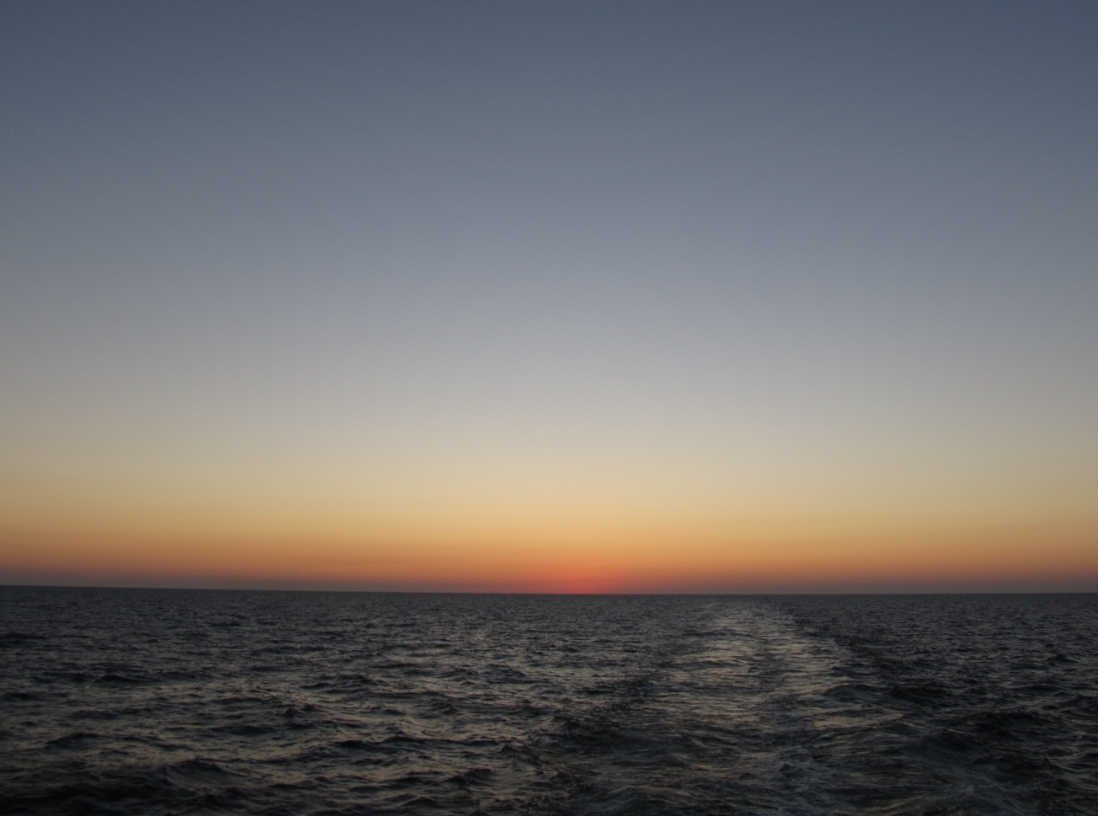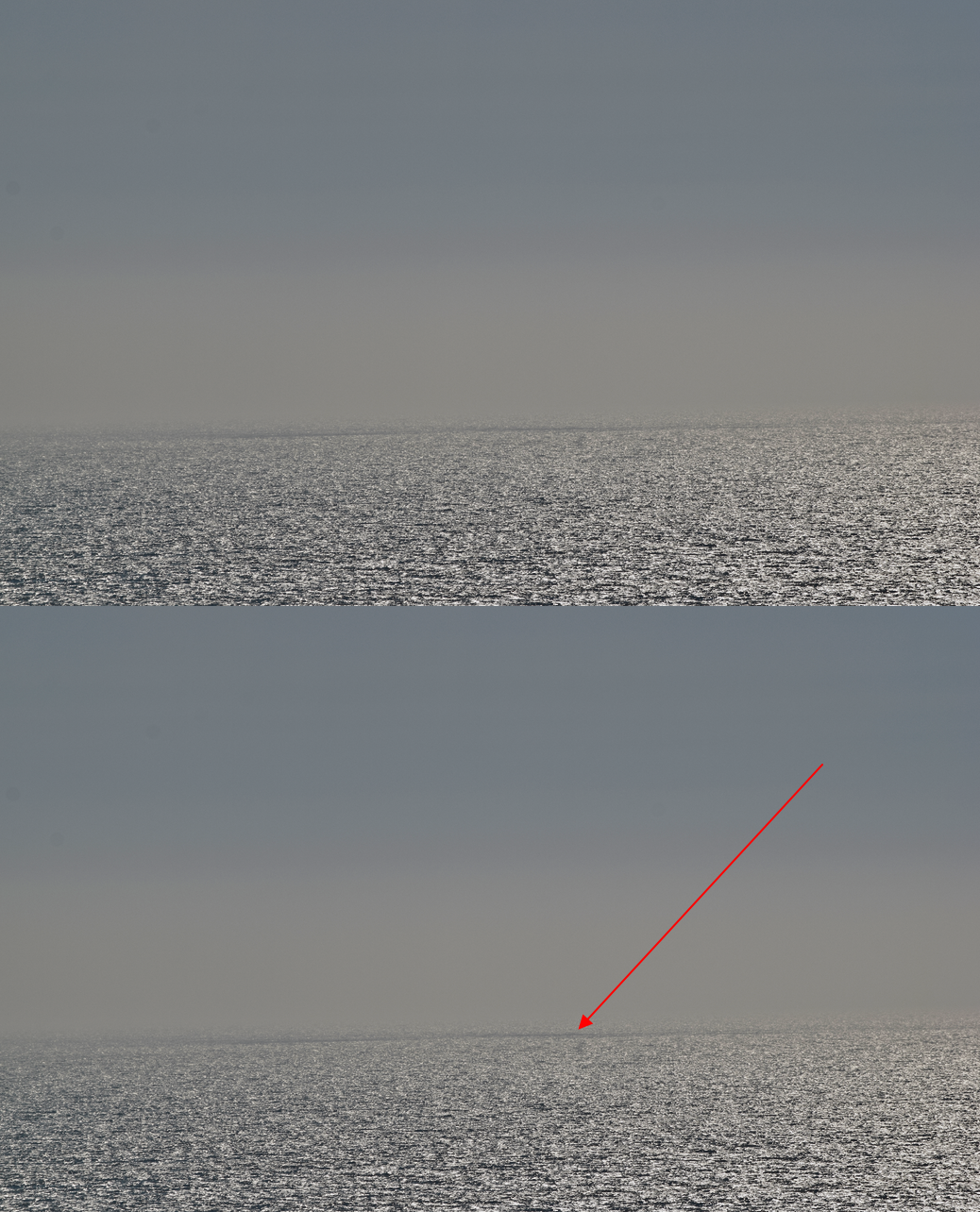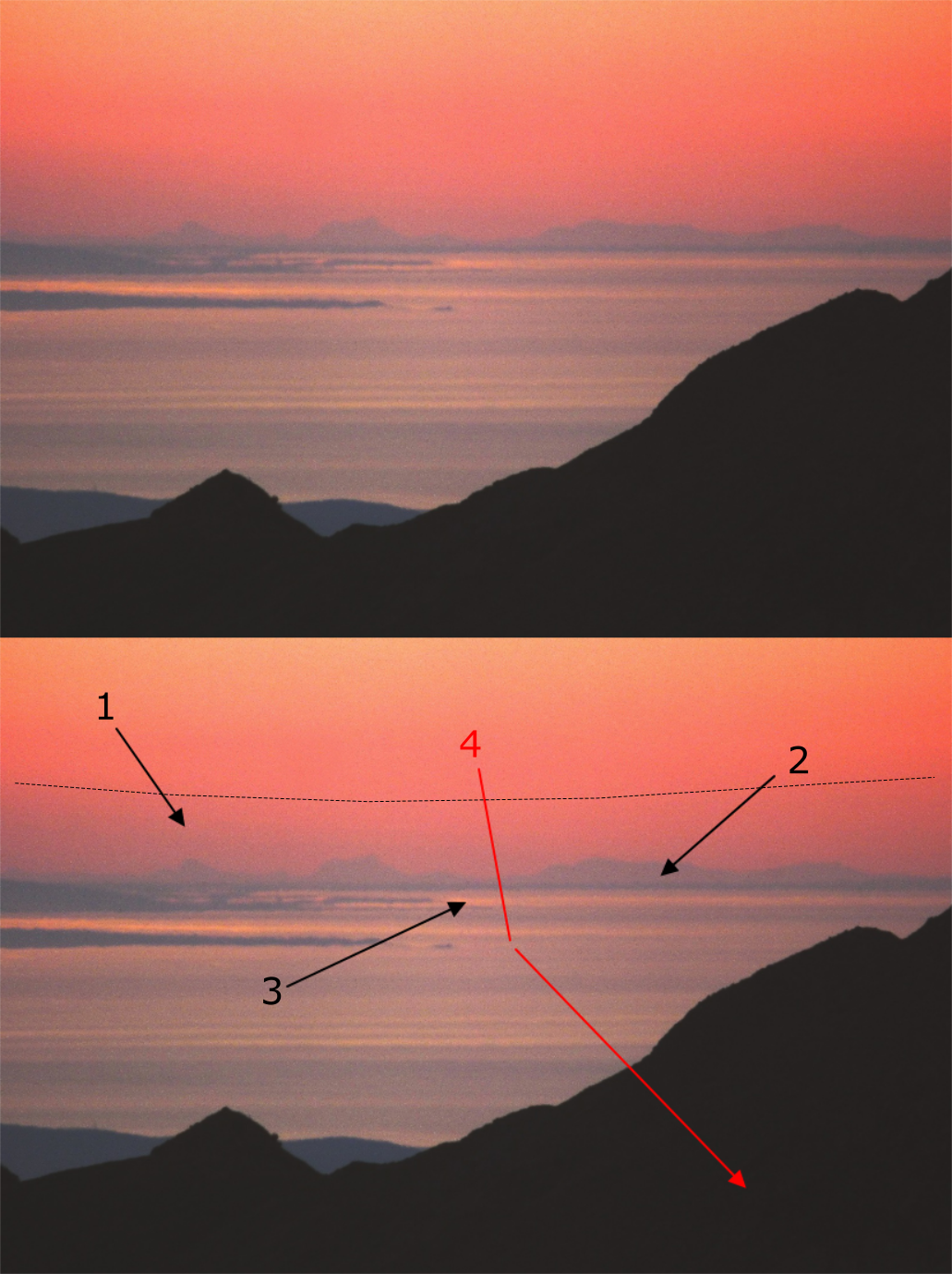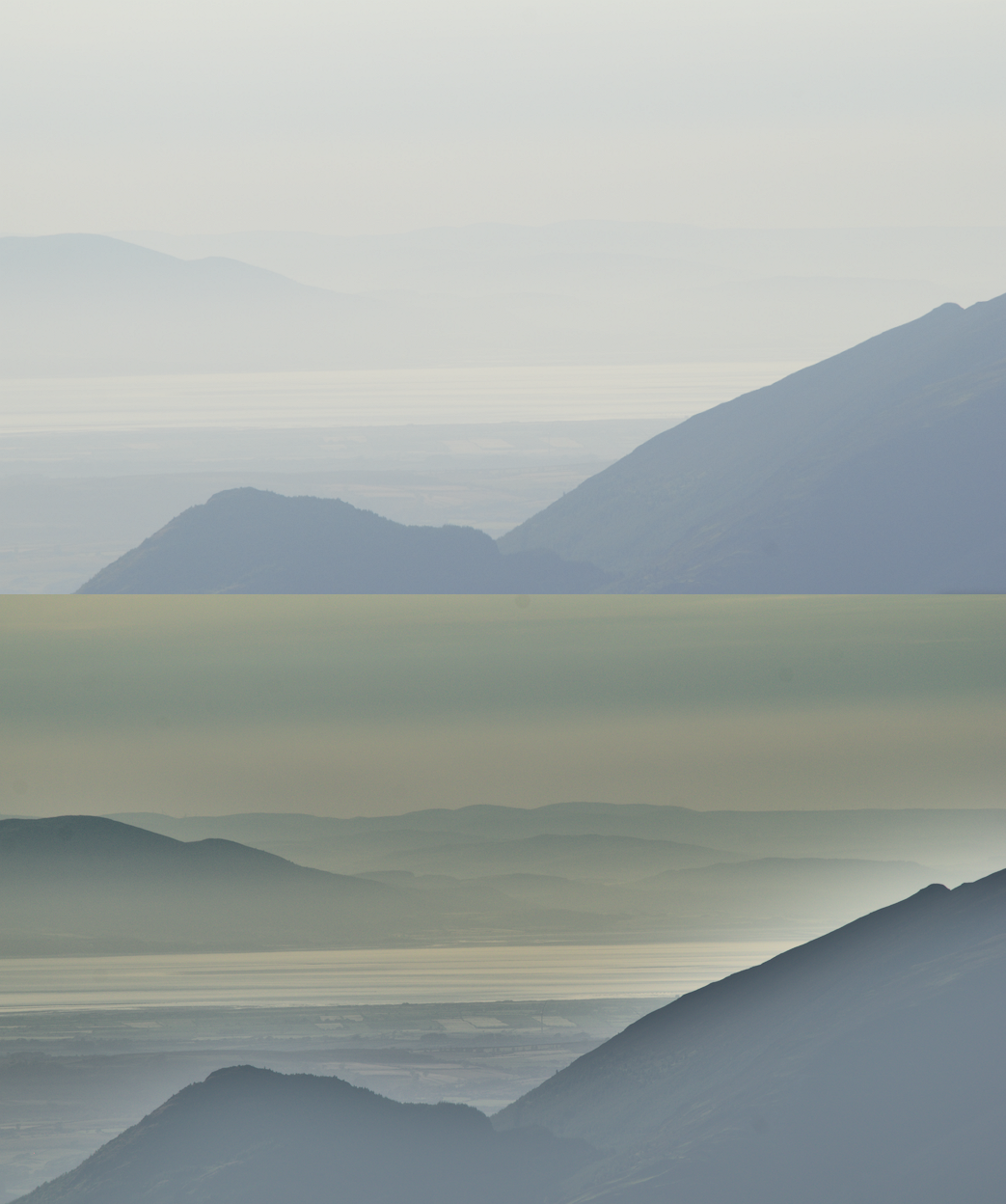The aspect of light reflection in the long-distance observations
This article presents the result of the longest distance observation in my life. Because it was an effect of the light phenomenon, not widely discussed by myself so far I decided to develop this topic, because of its influence on the far-reaching views during some specified conditions (tick haze trapped in the low-level of the atmospheric boundary layer or the proximity of water surface).
1. INTRODUCTION
It looks like there are still issues, which must be developed in order to clarify all optical phenomena contouring the possibilities of seeing long-distance features. In a recent article about it, light reflection has been described in relation to the specified object features (i.e. color). Apart from that, the optic phenomena shown there were concentrated in the broadly understood light diffusion in the atmosphere between an observer and the object watched. There is no proper information about the light reflection, as a factor facilitating the long-distance onlook. This is the key theme for this paper then. Besides the explanation of the phenomenon, future hints are to be given, regarding the on-site examples.
During the observation taken in the Lake District National Park in June 2019, it was found, that the light reflection appearance can change slightly the range of view towards the solar direction, even when the weather conditions are not perfect enough. Counterintuitively to the forward light scattering, deteriorating the vista towards the incident source of light, the light beams coming to the observer through the specular-looking reflection can considerably emphasize the contrast between two kinds of surface. One kind of surface is the light reflector (water and thick haze), and another kind is an object with a rough surface and low albedo. The optical features of the distant object observed differ completely from not only the surface, which tends to reflect the light but also from the horizon background beyond, being affected by forwarding scattering. Both specular reflection and diffuse reflection were mentioned in this article.
2. LIGHT REFLECTION ON WATER
Light reflection on the water happens because the water has a different wave impedance. Because this wave impedance is the fixed ratio of the electric and magnetic field amplitude of the light wave, these fields must be continuous in space which means, that they can’t change at the border of one medium and another. This is a direct consequence of Maxell equations, which describe the propagation of light. When the light beam hits the boundary of two separate materials with different wave impedance, then, as a result, a part of this light beam goes inside the denser material. The wave impedance difference between these two materials arises out of the contrasting resistance and causes the different refractive index, which is inversely proportional.
This is the basic principle for other laws dealing with reflection and refraction (Snell’s refractive index).
In the case of long-distance observation, we are mostly dealing with light reflection on the macro-scale water surface (big lake, sea, bay, etc.). The ubiquity of water waves, caused by winds makes this surface of water rough. On the open sea, the direction of waves is usually unobstructed by various obstacles, and it’s determined by the direction from where the wind is blowing. Anyhow, the presence of waves disturbs the reflection of light. It’s not a specular surface anymore, as the water surface is not smooth. Since the solar beams are reflected on the water waves in different directions, diffuse reflection takes place, as described in this article (Pic. 1).
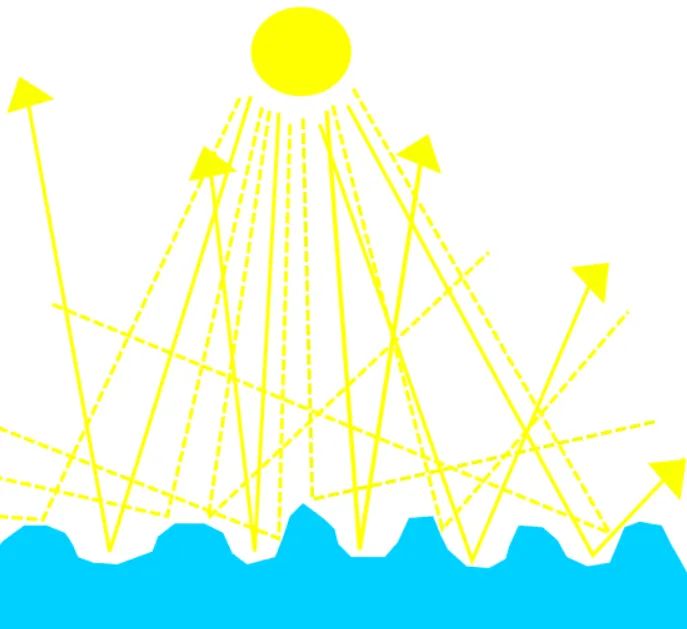
Pic. 1 The diffuse reflection pattern for the seawater surface (solid lines with arrows represent specularly reflected beams, dotted lines display diffusely reflected beams).
The diffuse light reflection makes the uniform reflectivity, which for the sea surface case can be described by Fresnel equations. Fresnel described the way of reflecting the light and its transmission into the denser medium, which in our case is the water (Pic. 2).
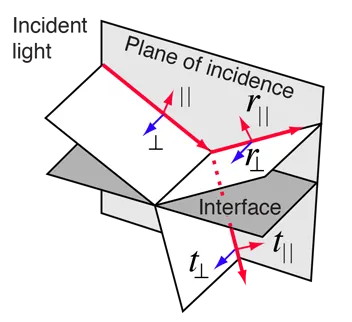
Pic. 2 The appliance of the Fresnel equation in case of the specular reflection (Hyperphysics.phy-astr.gsu.edu).
Considering the specular reflection as our simplified situation, it’s worth pointing out a couple of important things. First, the most important is the plane of incidence. This is the angle between a ray incident on the surface and a perpendicular line to the surface at the point of incidence. In other words, the angle of incidence is always equal to the angle of reflection in relation to the perpendicular (normal) line to the surface exactly, where the beam hits this surface. In this case, when the beam is almost parallel to the surface, we can say about the grazing angle (glancing angle) or grazing incidence. This angle is so important, as at the near-grazing incidence the media interfaces (initial light beams) appear mirror-like (Pic. 3).
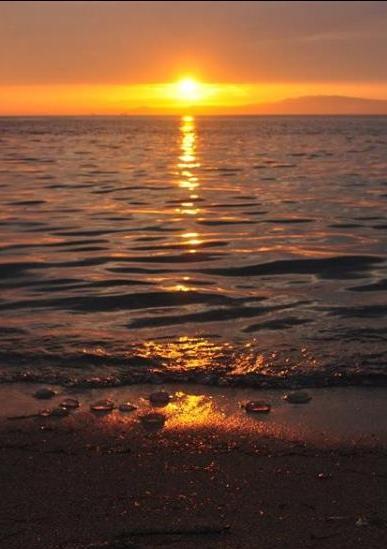
Pic. 3 A good example of near-grazing incidence, is when the Sun almost touches the seawater at the horizon (Wikimedia.org).
For an observer, the plane of incidence is the “place” where he can see the reflected beam on the surface (Pic. 3).
The multitude of waves, reflecting the light in all directions can produce the sun’s glitter. It can happen only when the portions of waves are oriented correctly to reflect the solar beam toward the observer’s eye. The exact pattern of this glitter depends on the watcher’s precise location. The size and color of this glitter are driven by the altitude of the Sun above the horizon. During the glancing angle conditions, the glitter can be broken by shadows cast by the waves themselves. Nevertheless, where you are, you always will see the same thing, when other circumstances (e.g. your height, the altitude of the sun) remain constant (Pic. 4).
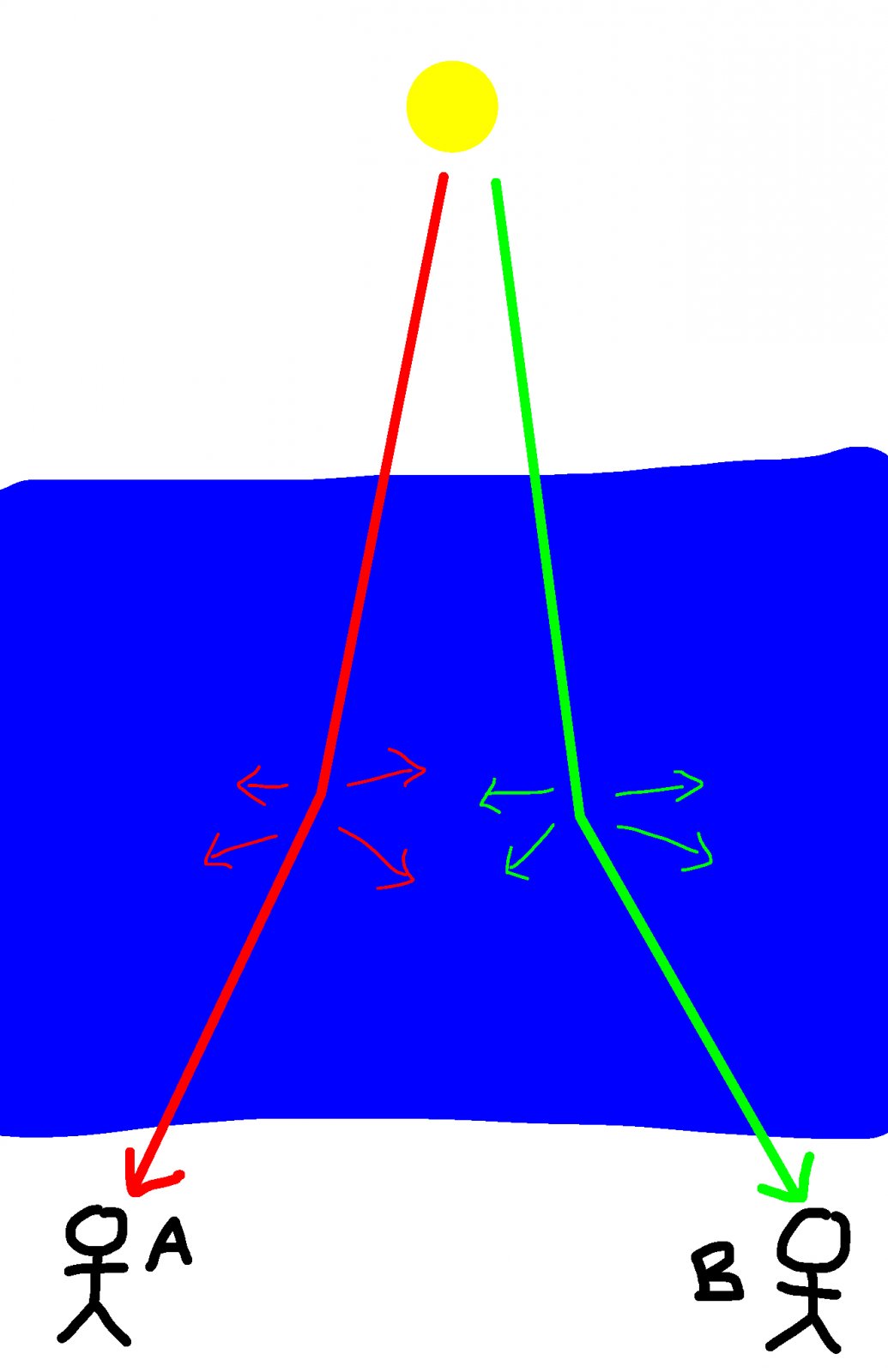
Pic. 4 The Fresnel light reflection pattern remains the same for two observers watching the Sun’s glitter at the same time at different locations (Metabunk.org).
This pattern won’t be exactly the same, because the glitter trail is made by a multitude of suns, quote easily recognizable as an image of the Sun. They come and go on an instant basis. Every single “Sun” is a little mirror because the perfectly smooth surface can contain only one glint. These glints are mostly elliptical, with an aspect ratio that depends on the observer’s altitude (Lynch, Livingston 1995) (Pic. 5) The pattern will be unique for each observer.
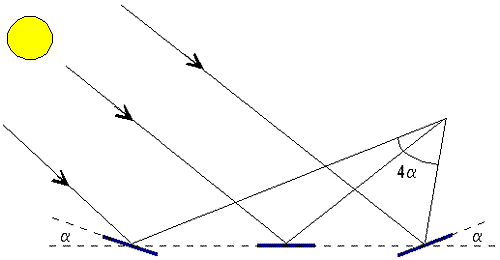
Pic. 5 The pattern of the Sun’s glitter, depending on the observer’s altitude (Esrl.noaa.gov).
Before I start describing, what happens in the opposite situation I would like to point out the second thing stated in the Fresnel equation, which is the light beam transmission to the different medium (Pic. 2). This transmission is related here to the refractive index, described by Snell’s law.
In the other situation, when the Sun is high above the horizon, the seawater looks bright and evenly illuminated. It happens only during the summer period when the Sun is higher than 50 degrees above the horizon. There is basically no difference in the sea surface illumination. The reflectance of solar beams from the seawater is 3%. When the Sun is lower, the light reflectance increases. It’s twice as high when the Sun is 30 degrees above the horizon and almost 10x higher when the Sun’s position is just 10 degrees above the horizon. For the 5 degrees altitude, the reflectance percentage is 42%. Analyzing it under the smooth ocean surface conditions, we can say, that the light reflectance is inversely proportional to the light penetration, which is always the highest when Sun crosses the zenith. Since latitude plays a role in the elevation of the Sun above the horizon, light penetration is always less at higher latitudes (Rafferty, 2011). In the case of the aforementioned light reflectance, it can be quite upside down, when we see the rough sea with waves. Then the light reflectance will be higher, as higher is the Sun.
To compare the situation of light reflection by seawater at the different parts of the day let’s see the images below (Pic. 6-9).
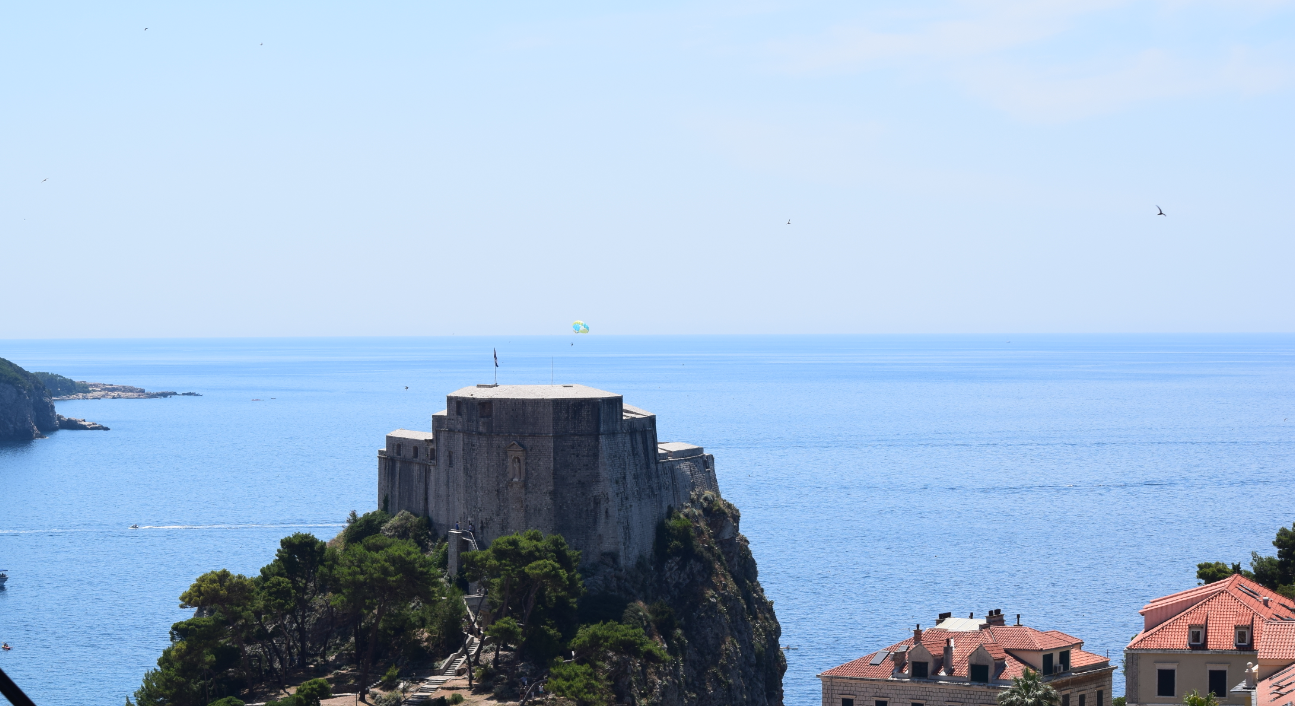
Pic. 6 The Dubrovnik castle with the Adriatic Sea beyond. The high altitude of the Sun during the midday time hours causes low reflectance on the relatively smooth sea surface. Dubrovnik, Croatia.
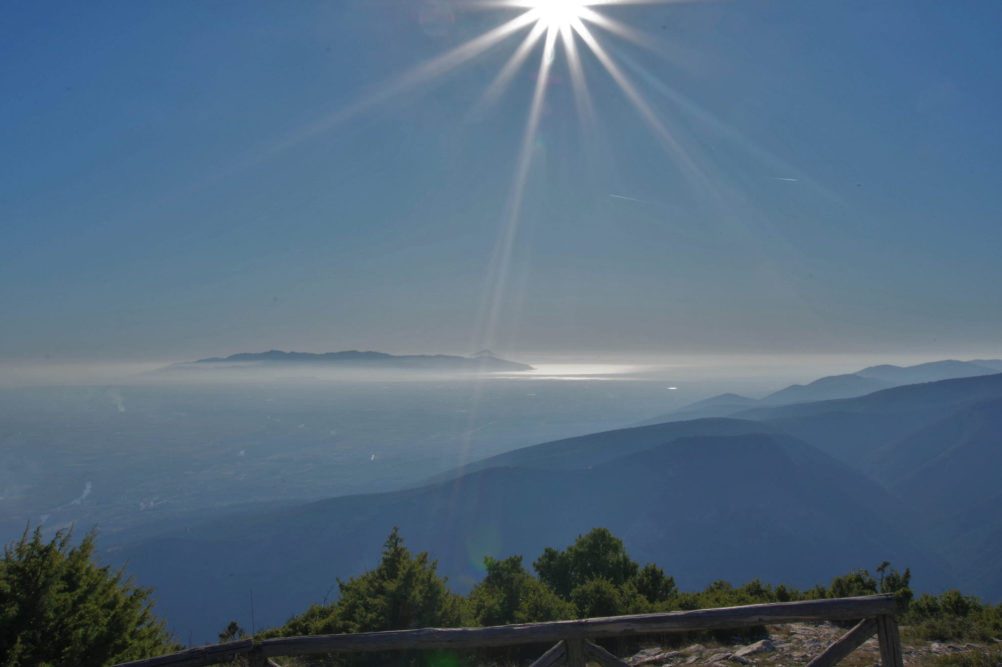
Pic. 7 When the Sun is lower, then we can see some glitters near the horizon, which corresponds to the right angle with an observer’s eye. This angle applies only to the distant water mass and is different for the closest water body. Hence the closer body of water is not reflecting the sunlight at this moment. Moreover, the island affected by the sun’s glitter features emphasized contrast with the body of water, despite the thick haze layer occurrence (Nik Kakagias/500px.com).
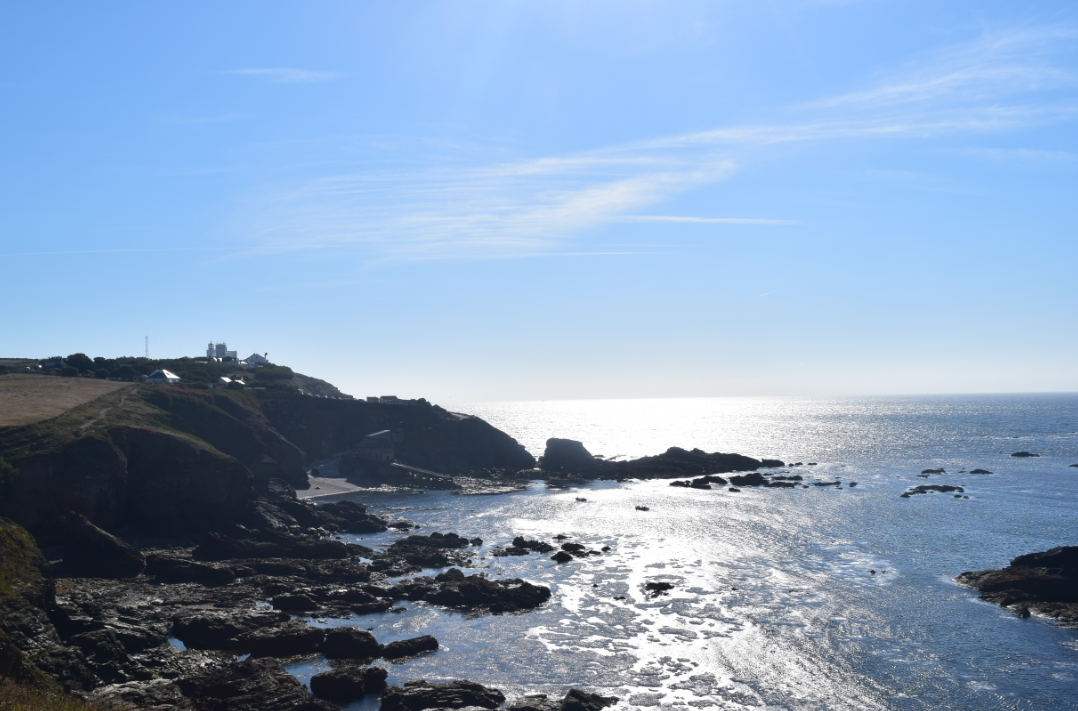
Pic. 7 The solar beams reflected on the water’s surface during the morning hours. Take a look at the path of reflection, which faints toward an observer, as the angle changes. Lizard Point, United Kingdom.
Now, looking for the Pic. 1,7,8 we can spot another example of diffuse reflection on the sea surface. The angle of the incident doesn’t appear as a straight line. Its borders are very fuzzy, and finally moving your sight further from this angle, you can spot a gentle reduction of single glitters. Each glitter, as discussed above is a small and smooth mirror, reflecting the solar beam perfectly. It is the result of the water wave shape, featuring surfaces tilted in many directions.
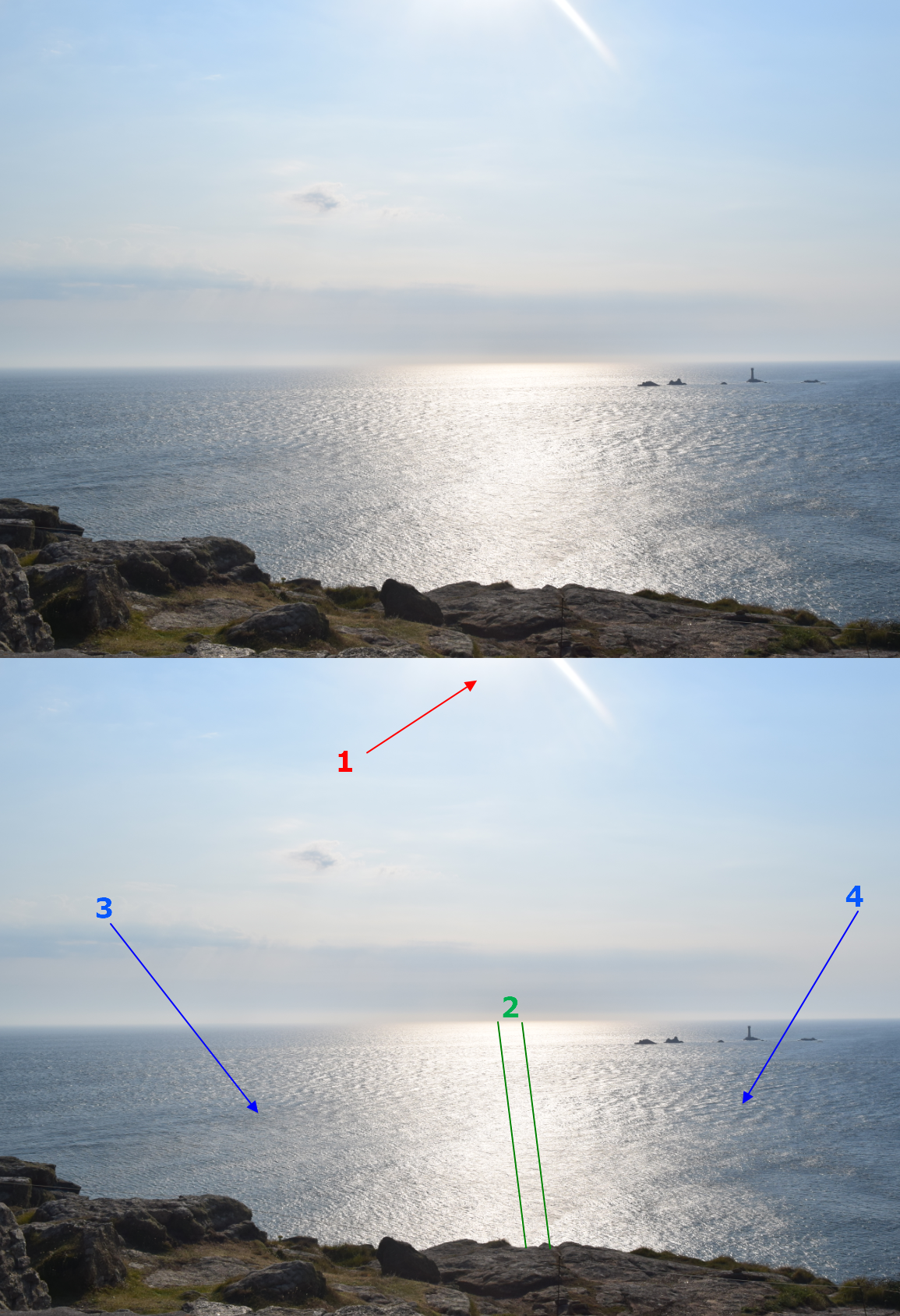
Pic. 8 The seawater light reflection detailed pattern, where: 1 – position of the Sun (just outside of the frame, see the white flare on the top); 2 – the angle of incidence (intentionally shown as a wider path, corresponding to the solar disk angular diameter); 3 – the area of single glitters caused by waviness, which amount smoothly faints as move your sight further from the plane of incidence. Land’s End, United Kingdom.
Take a look again at this view, presented in the enhanced picture below (Pic. 9), where we can see sudden darkening at the horizon, just above the plane of incidence, where the solar beams are reflected.
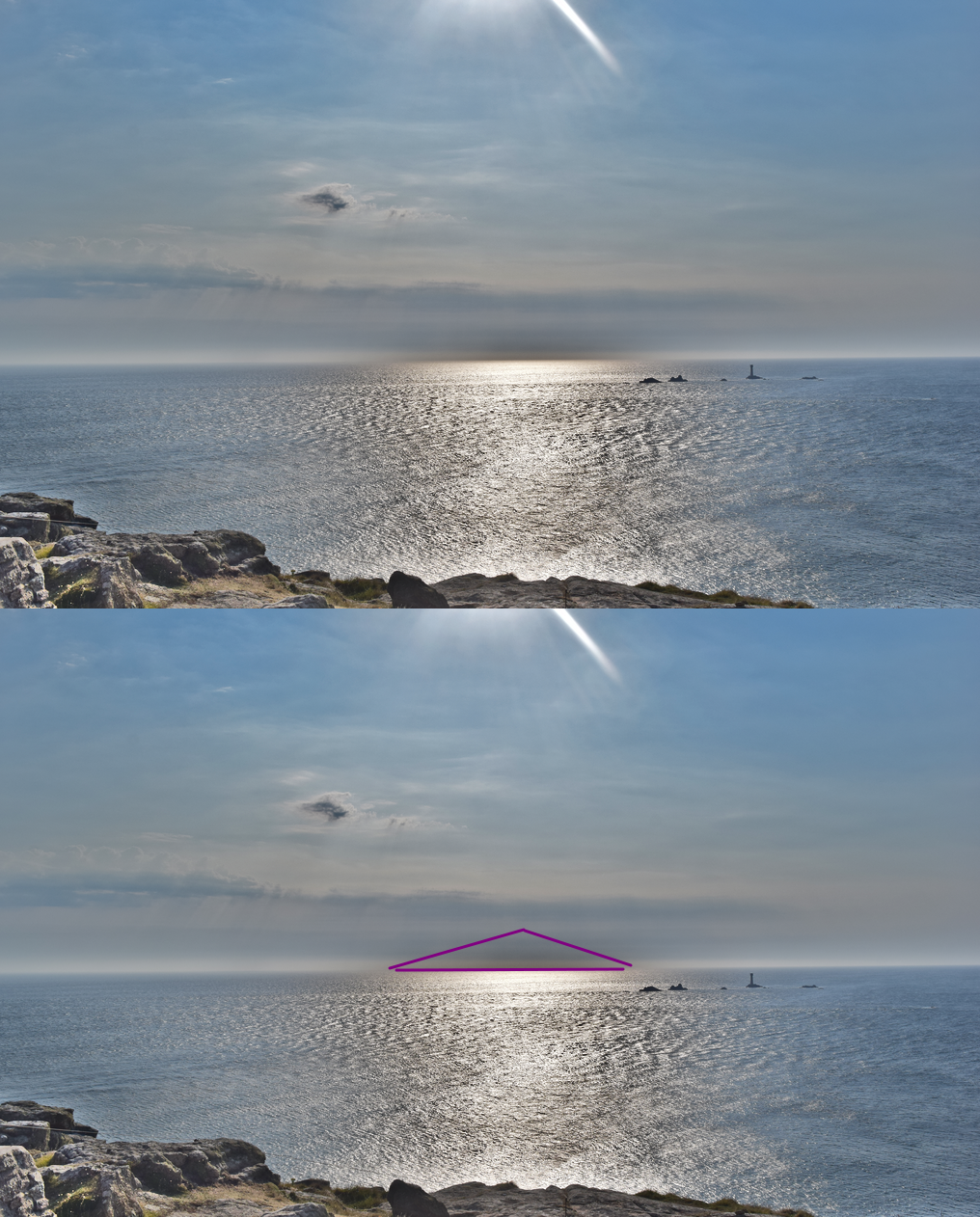
Pic. 9 The contrast triangle optical phenomenon, appearing always at the horizon, just above the solar or lunar plane of incidence.
This is the contrast triangle optical illusion, seen as a dark triangle sitting on the horizon above the brighter glitter of sunlight (moonlight)(Lynch, Livingston, 1995). From where this triangle does come? It’s caused by a relatively much brighter glitter of sunlight, which puts the haze above the horizon into a darker appearance. Look and see both sides on the left and right, outside of the solar angle of incidence, where the water surface has lower illuminance to the haze, which appears just above. This is fully understandable because the haze located towards the solar direction is affected by the forward scattering of light and, hence features a higher level of luminance. The situation changes diametrically when the haze layer lies at the plane of incidence. Then, the much brighter sea surface beats up the less bright haze, making it relatively darker. This optical illusion is such a paradox, because the “location” of this haze just above the glitter of sunlight means, that it’s the closest to the Sun then. When is the closest to the Sun, the forward scattering is the strongest, so theoretically it should peak its brightness. In a practical sense, this level of brightness is still far lower, than the brightness of the solar glitters appearing on the water in the same direction and, therefore looks darker. The top of the triangle points roughly to the angle of incidence. If you would take a general look, from a further distance, then you can notice, that clouds just above this glitter of sunlight also tend to be a bit darker. It can be translated slightly into distant object observations (Pic. 17), which is characterized below.
Another thing, which is vital to say at this moment refers to any other kind of light reflected by seawater. Till now, we were considering only one angle of incidence, by which the strongest light (sunlight) is reflected. As you see in Pic. 8, the Seawater looks blue outside of the sun’s glitters, however, if you take a more detailed look, you will spot, that the waves tend to reflect another light apart from the solar beams. If you stood there and turned your sight further to the right or on the left, you would have another plane of incidents, generated by different sources of light (Pic. 9). The best way to see it is the seaside during the night. You can have one plane of incidence from the Moon for instance, and another one from the light reflectors, etc. During the day, the situation is different, as there is no source of direct light as strong as the solar one. Concluding, these other angles of incidence come from the sky itself and some objects, which appear mirror-like on the water, especially smooth, and when our angle of view is similar to their angular height. However, this is a minor thing, as for long-distance observation purposes only the sky as an entirety is considered. Therefore apart from the solar angle of incidence, there are different ones coming from any kind of clouds and different regions of the sky, as follows (Pic. 10).
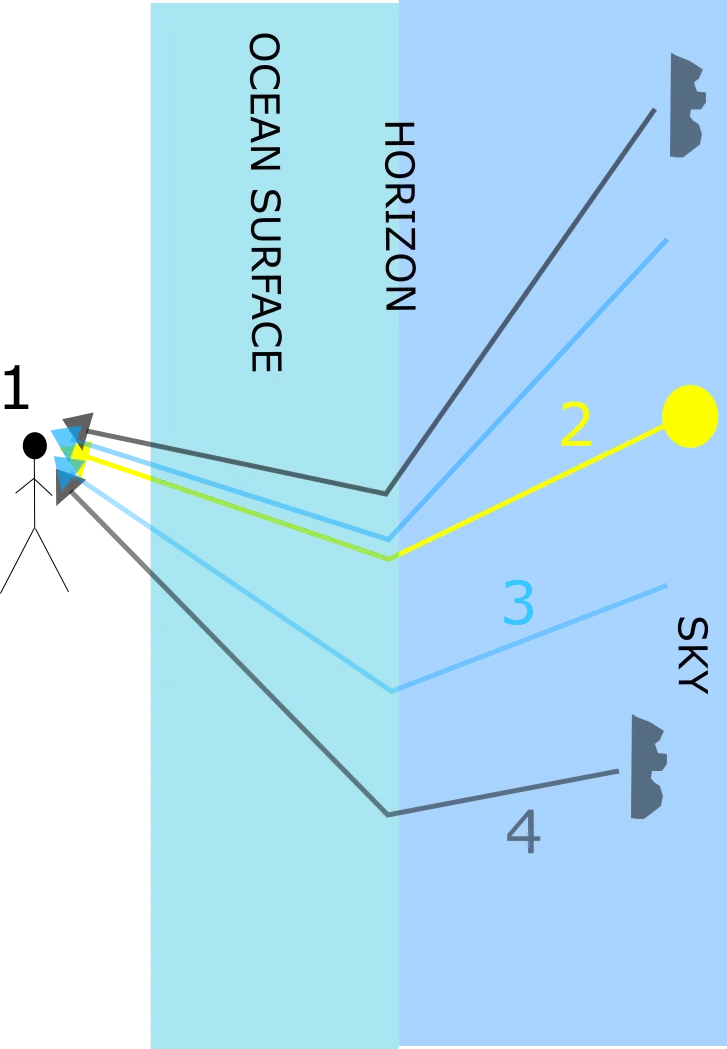
Pic. 10 The multitude of planes of incidence pattern, where: 1 – An observer; 2 – Plane of incidence from the Sun; 3 – Plane of incidence from the cloud; 4 – Plane of incidence from the sky.
To understand it better let’s consider the situation when the day is overcast. Lack of Sun means the lack of direct light, which means, that any glitter cannot be visible. In this event, the sea surface will reflect the scattered amount of light from the particular section of the sky, depending on the plane of incidence taken (Pic. 11).
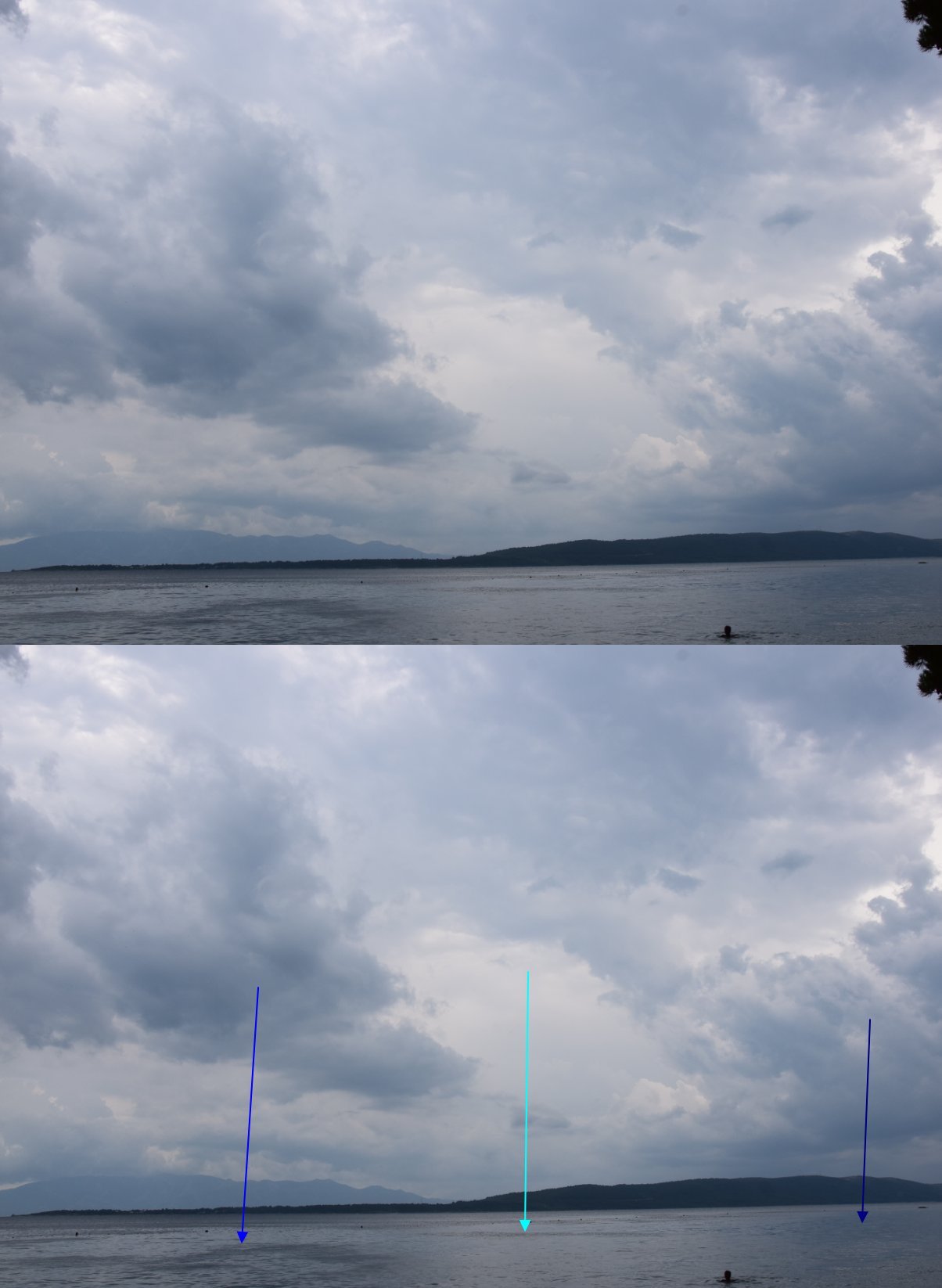
Pic. 11 The scattered light reflected on the sea surface when the sky is full of clouds. The lighter arrow shows the plane of incidence from the brightest section of the sky, whereas the darker arrows represent the sky areas with a lower level of scattered light. Mala Duba, Croatia.
An analog phenomenon occurs after sunset when the horizon towards the solar azimuth remains bright for a long time. It is also reflected in the sea (Pic. 12, 13).
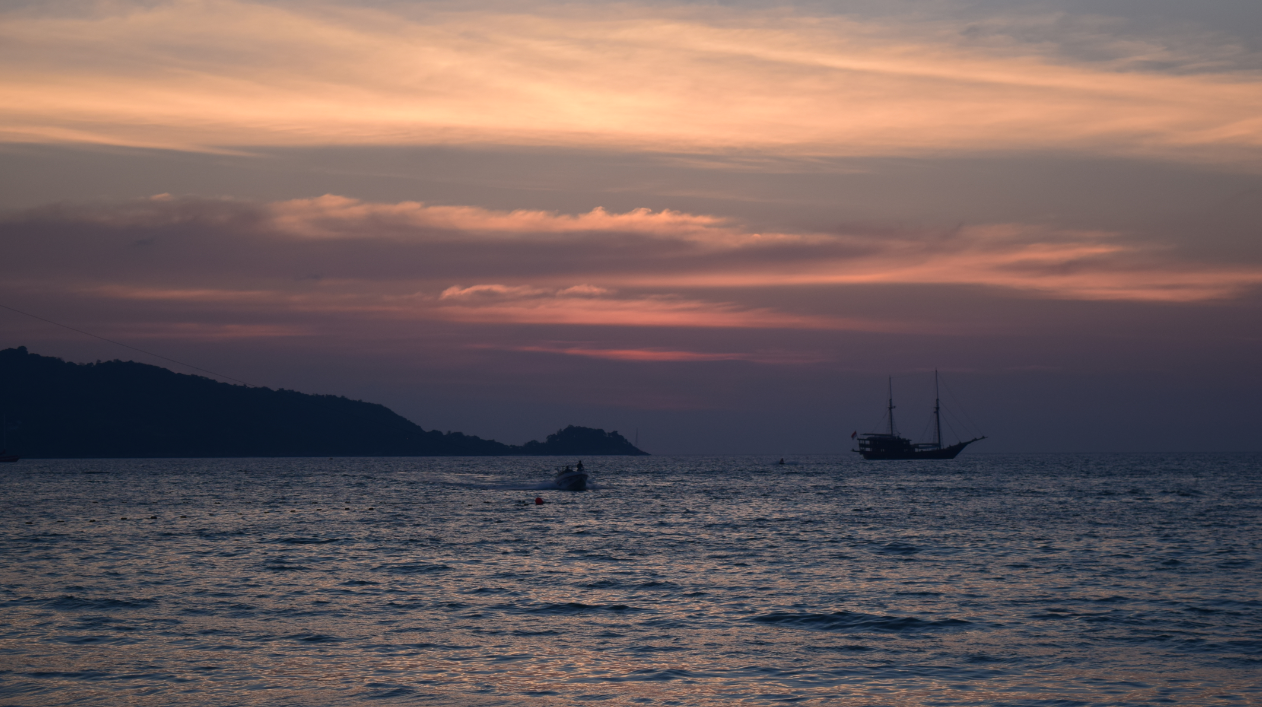
Pic. 13 Another example of the seawater reflection after sunset, where the high-level cloud presence (still illuminated) can enhance the effect at the plane of incidence. As a result, the reddish tints on the waves are observed. Phuket, Thailand.
I think, that this sort of image has explained this phenomenon enough. I believe, that it doesn’t say a lot about the distant views so far unless we consider some sun glitters possible to see far away. Apart from the seawater, it can be produced also on the lake surfaces, which takes the form of a glint. The difference between glitter and glint is basically the time. Glint is the moment, when the light is reflected, unlike glitter, which lasts for a longer time. Nevertheless from the type of water body, these phenomena can be seen far away, due to light strength. A good example comes from Rzeszów in Poland, where the glint produced by Strbske Lake in Slovak Tatra Mts was seen from a 179km distance (Pic. 14, 15).
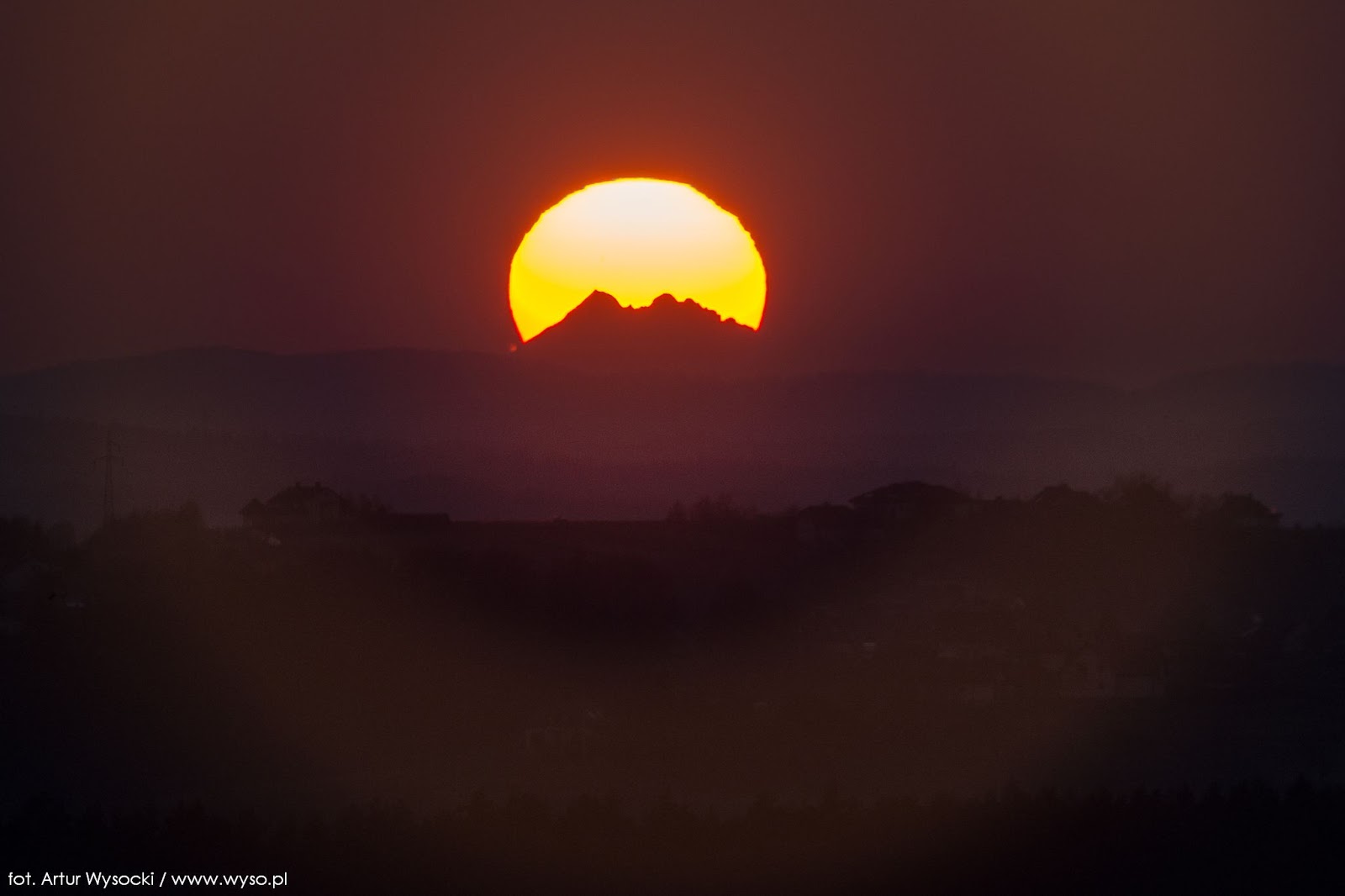

Pic. 14, 15 – The Sun’s glint seen from 179km distance near Rzeszów (Poland), just next to the setting Sun above Tatra Mts. (Artur Wysocki/Wyso.pl/Pawel Rzucidlo/Rzeszow-tatry.blogspot.com).
There is one important thing, inherent with the water light reflection and other objects or landmasses, which don’t have this feature. This is obviously the contrast produced by the difference in illumination between the water, the sky just above the horizon, and obviously the object, which we wish to observe. Let’s consider 2 major cases, which can occur during our observation.
The first one applies to the situation when we are looking exactly towards the solar azimuth, roughly alongside the plane of incidence (Pic. 16). We can expect the contrast triangle (Pic. 17, 19), but also the blindness by reflected sunlight (Pic. 18).
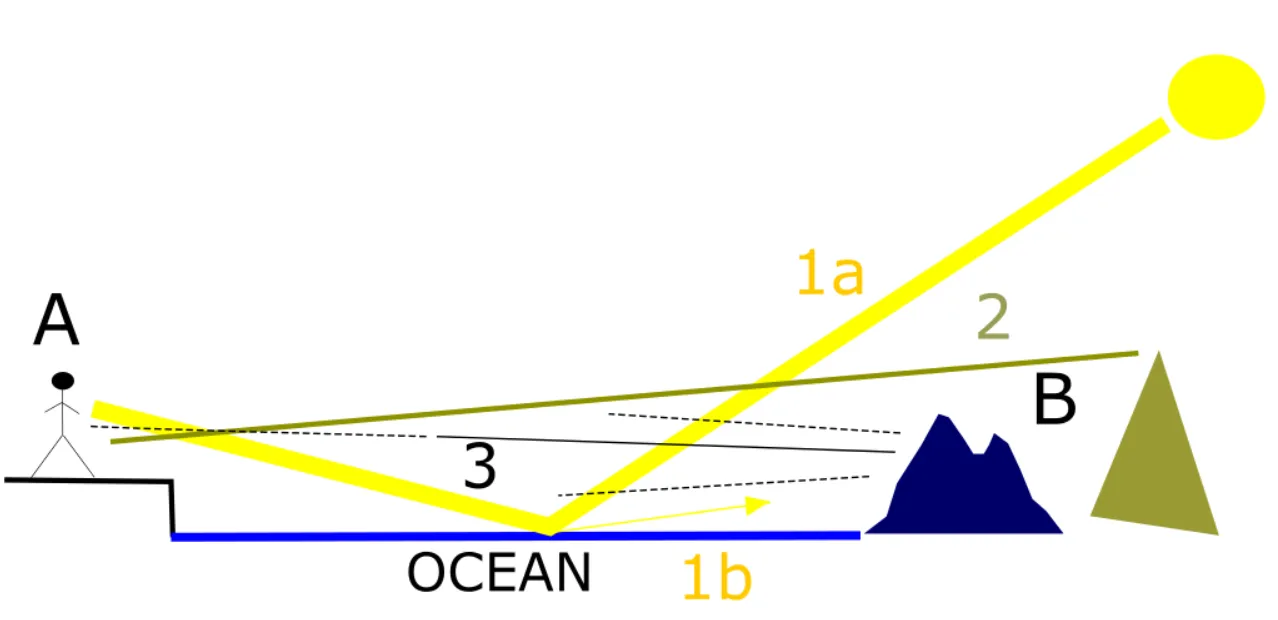
Pic. 17 Long-distance observations possibility when looking exactly alongside the angle of incidence, where: A – observer; B – object observed; 1a – solar beam plane of incidence; 1b – possible blindness caused by bright reflected sunlight; 2 – the contrast triangle and scattered light reaching the observer’s eye; 3 – distant object, which tends to be dark due to the lowest luminance level. Its appearance can be deteriorated by a much brighter haze being on the way to the observer, hence the lines are dotted.
In this event, we can face the little contrast enhancement between a distant object and the sea surface. The optical illusion of making the haze darker will work likewise the dehazing feature (Pic. 19). However, if the angle of the solar beam is not favorable enough, then glitters can blind an observer and make both objects and the contrast triangle invisible (Pic. 18).

Pic. 18 View towards the solar azimuth, where the solar beams reflected on the sky tend to blind an observer. As a result, the view of the distant object as well as the contrast triangle can strongly deteriorate. See how it works with the close object observed at the 2km distance. Newquay, United Kingdom.

Pic. 19 View on the Isle of Scilly from the Land’s End in Cornwall (47km distance). The object is at the JND due to a thick haze. The contrast triangle presence (which has been seriously flattened due to long lens usage), the visual range has been pushed a few kilometers ahead.
The second case applies to the situation when the distant object doesn’t lie directly under the Sun, but a bit outside. In this event the seawater can be still affected by glitters, as the diffused reflection takes hold, although the plane of incidence will be related to the scattered light coming from the near-horizontal sky (Pic. 21). This geometry appears to be the best for long-distance observations on the sea because the contrast between the distant object and bright surrounding is the highest.
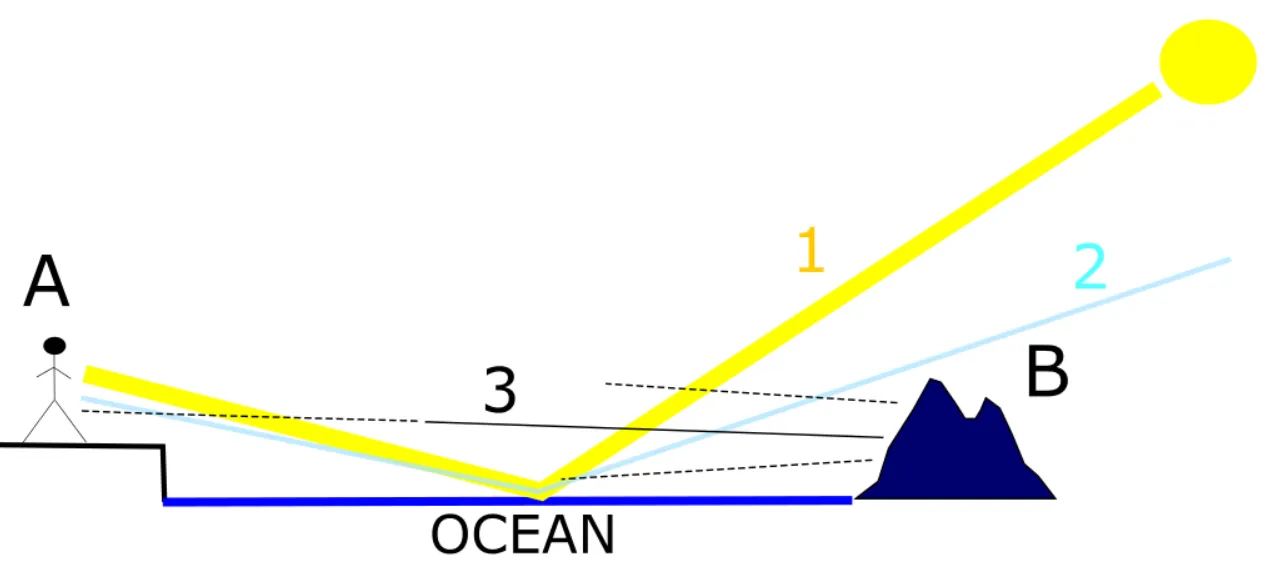
Pic. 20. The long-distance observation pattern, when the observer is looking not directly at the solar azimuth, where: A – observer; B – distant object observed; 1 – the plane of incidence from the Sun being next to, which due to diffuse reflection can appear on the ocean surface as smoothly disappearing glitters; 2 – Appropriate angle of incidence for the observer with the scattered light coming from the near-horizontal part of the sky (sometimes even from the atmospheric boundary layer); 3 – the light coming from the distant object, which tends to be dark because its surface illumination is the lowest. The way of this light has been shown as a dotted line because it tends to be deteriorated by a much brighter haze on its way to the observer.

Pic. 21 An example of an enhanced contrast of the distant feature, is when the sea is just outside of the solar angle of incidence and reflects bright and intensively forward scattered light from the near-sun sky. Even, when the sky beyond is overcast, the contrast between illuminated water and the land beyond facilitates distinguishing the object. View towards the Galloway Forest Park Hills from the Lake District, United Kingdom.
The last thing, which must be mentioned here is the presence of clouds itself on the way between the distant object and the observer. The full explanation of how it works can be found here. I just would like to show it from the misleading side. I experienced many times situations when the sun’s glitter on the sea surface was broken by shadows cast by any kind of cloud. It can be an even thick cirrostratus cloud, which partially blocks the direct sunlight hitting the water. As a consequence, an observer can see mostly elongated darker patches on the ocean surface. If they are close enough to the horizon, they can be mistaken for some distant objects possible to see in that direction, especially when the visibility is poor (Pic. 22).
The last thing to indicate in this section is the role of contrast at the sea when the Sun is gone. Let’s see what was happening when Mark Bret took a picture of the longest ground-based distance observation ever (Pic. 23, 24).
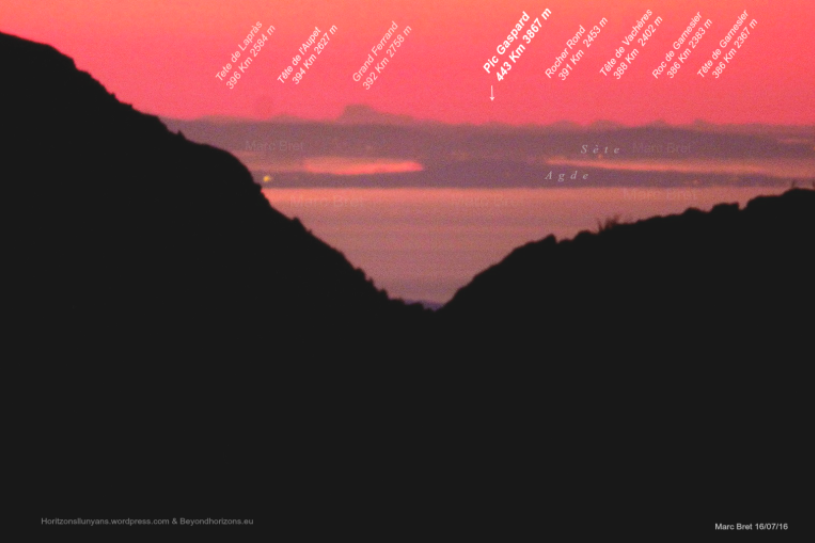
Pic. 23, 24 The longest landscape photography in the world. Picture taken before the sunrise, where: 1 – atmospheric extinction deteriorating the contrast of horizontal sky; 2 – Remote landmass visible; 3 – water body reflecting the light scattered in the atmosphere before sunrise (water looks more greenish as closer); 4 – the plane of incidence showing how the diffused sky was reflected on the seawater to the observer. Pic. 19 is the confirmation of this situation; the distant land visible has been “isolated” by greenish light scattered in the atmosphere before sunrise and next reflected from the sea. The polarizing filter has been used for this image, which additionally emphasizes the contrasts. (Mark Bret/beyondhorizons.org).
Basically, the scattered light reflected by the seawater during the twilight period can emphasize the contrast with distant objects, possible to see from the opposite part of the water body, especially when the atmospheric extinction tends to impair the contrast of this landmass with the sky beyond. Nevertheless of extinction, the biggest contrast is produced between the object and the still illuminated portion of the atmosphere beyond.

Pic. 25 Illes Medes (Costa Brava) seen from the Massis del Montseny. The perfect example of a distant view is when the sun’s glitters reflected on the seawater are abruptly interrupted by land, which doesn’t have reflection features (Mark Bret/beyondhorizons.org).
3. LIGHT REFLECTION ON HAZE AND CLOUD DECK
The geometrical mechanism of light reflection on the haze is pretty much similar to the reflection on the water. It means, that the phenomenon happens in accompany by the plane of incidence, as described above. However, we cannot really assign the Fresnel law to the haze, unless it features a high gloss, which rather doesn’t happen in meteorology. Previously the light scattering issue was widely discussed in my works, especially in this article. The point is, that the haze problems were portrayed only from the light-scattering side. I haven’t had an occasion really to take a look at the haze layer from outside, where the light reflection takes place. A multitude of small bodies packed together within the haze layer scatters the light inside this layer, transmitting it to the Earth’s surface. However, not all sunlight reaches the ground, because a part of it is reflected by the top deck. See below the mechanism of light distribution in Earth’s atmosphere for a better understanding (Pic. 26).
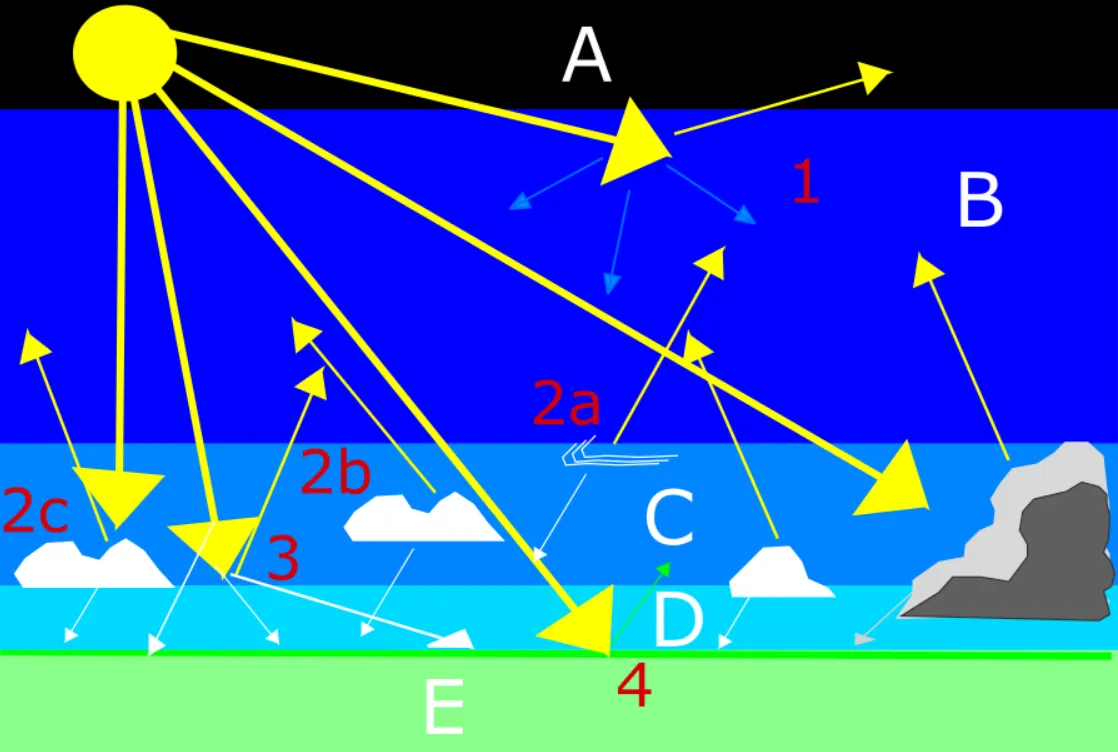
Pic. 26 The light distribution in the Earth’s atmosphere – a very simplified pattern, where: A – upper atmosphere or space; B – the lower atmosphere (ozone layer and beneath); C – troposphere; D – planetary boundary layer (haze); E – ground. Each layer can be considered twofold, as a medium, which scatters the light, and also as a medium which reflects the light: 1 – light reflection from upper Earth’s atmosphere to the space and rayleigh scattering producing diffuse sky radiation); 2a – light reflection and scattering by high-level clouds; 3 – the same for middle-level clouds; 4 – the same for low-level clouds forming the capping inversion and the other inversion layer at the very top of the planetary boundary layer; 3 – light scattering and reflection by the atmospheric boundary layer (haze); 4 – light reflection and scattering by ground.
We must attempt each layer twofold. When looking from the inside of the layer and when looking at it from the outside. The light scattering by Earth’s atmosphere, in general, has been widely described here, and by clouds and haze in this article. I haven’t done so many works within the light reflection by haze, so let’s do it now.
If we want to see the light reflection by haze, we must be above the haze deck, which eventually will remain the plain water surface, although the optical properties of the haze and water are different, as these two separate mediums are represented by different sizes of the particles, and what the most important – physical states. Both scatter and reflect the light, although the huge difference in the density grades these two substances significantly. Even if the optical geometry remains analog, the way of light distribution won’t be the same. Standing above the smooth waterbody layer, we can experience the specular reflection of light. If we are located above the haze deck, which appears to be the layered haze, then we can experience an analog way of light reflection. It won’t be the specular reflection, because the haze represents a different physical state. Hence the light won’t be reflected ideally exactly towards the given direction, but the angle of reflection will be much wider as it happens on smallish particles (Pic. 27).
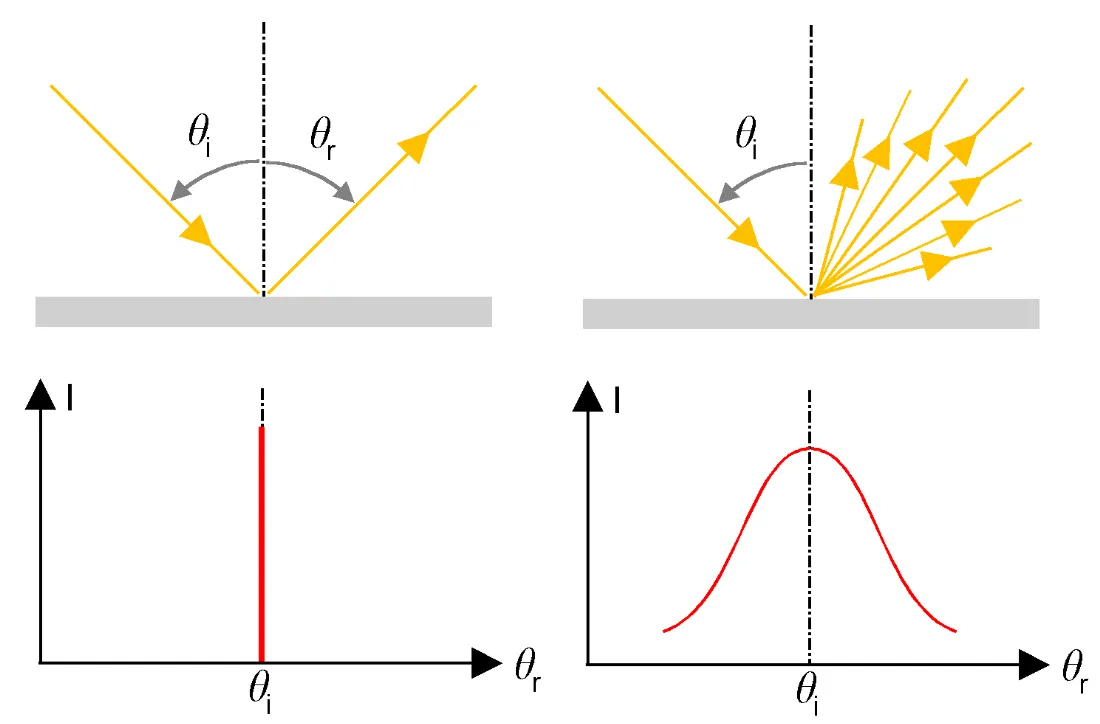
Pic. 27 The light reflection patterns for water and haze, where on the left you have the specular reflection, and on the right, you see the haze reflection (reflection haze), which is not ideal as the specular reflection is. As a consequence, the angle of reflected means will be wider with the biggest amount towards the specified direction (Wikimedia.org).
This situation is perfectly displayed in the charts above (Pic. 27). For the specular type of reflection, the beams head toward one certain direction. That’s why the reflected landscape can be copied on the plain water surface. In the case of haze, the angle of reflection is much wider, because the solar beam is cloven on the smallish particles. However, the biggest concentration of the reproduced beams falls in the specified direction, as shown on the chart above on the right. Looking away from this specified direction, the amount of beams reflected drop is cosinus-like. To make it simple, the plane of incidence will be blurred in case of the haze, unlike the water, which is marked clearly (Pic. 28).
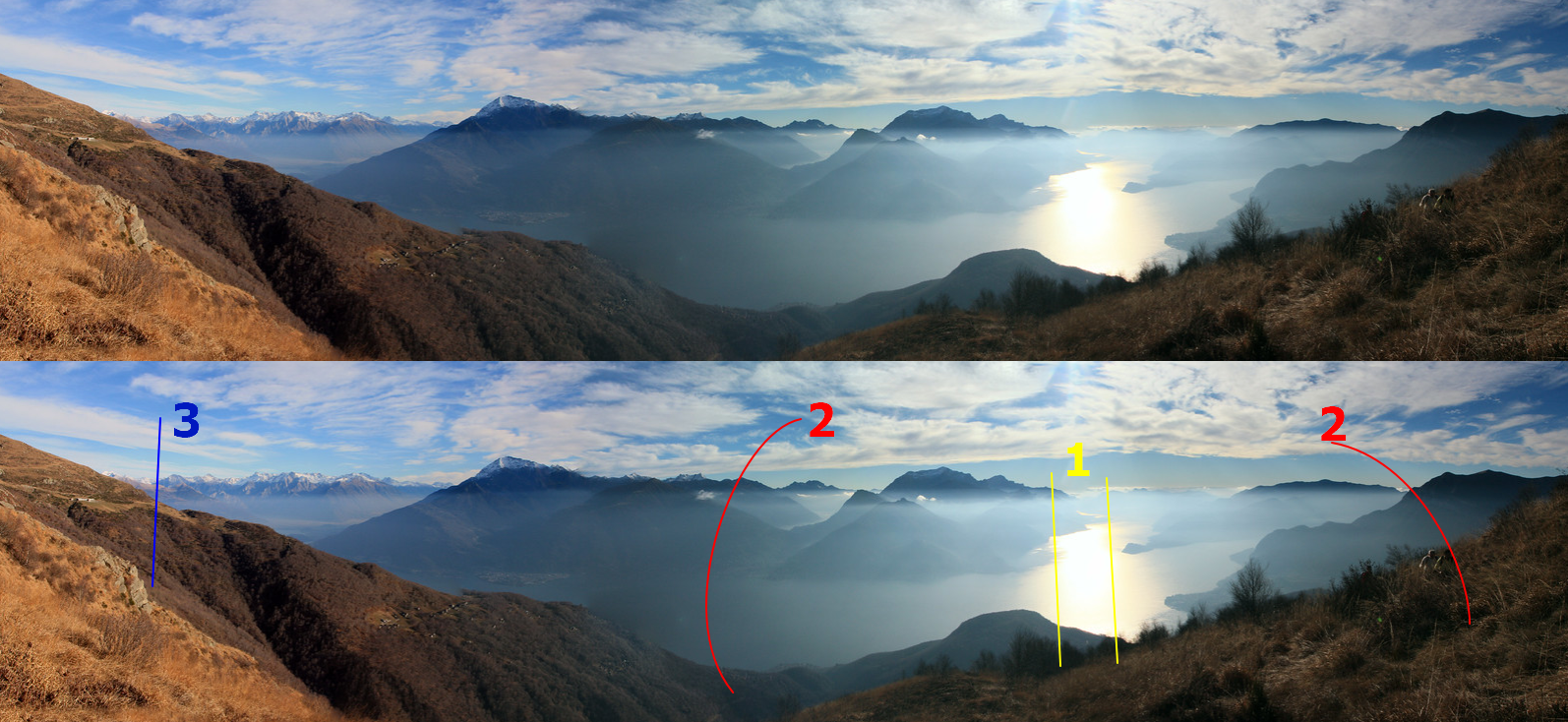
Pic. 28 A good example, is where both water and a thin haze layer reflect the light. You can see the considerable difference between them two: 1 – the plane of incidence, marked by a multitude of glitters on the water’s surface. Moreover, the haze deck is the brightest, when looking towards this direction; 2 – the border of light reflection by haze, which becomes fainter as it moves away from the angle of incidence; 3 – presumed 90 degrees angle from the Sun, where the forward light scattering terminates and light polarization takes place (Michelle D’amico – view on the Como Lake with reflections/Flickr.com).

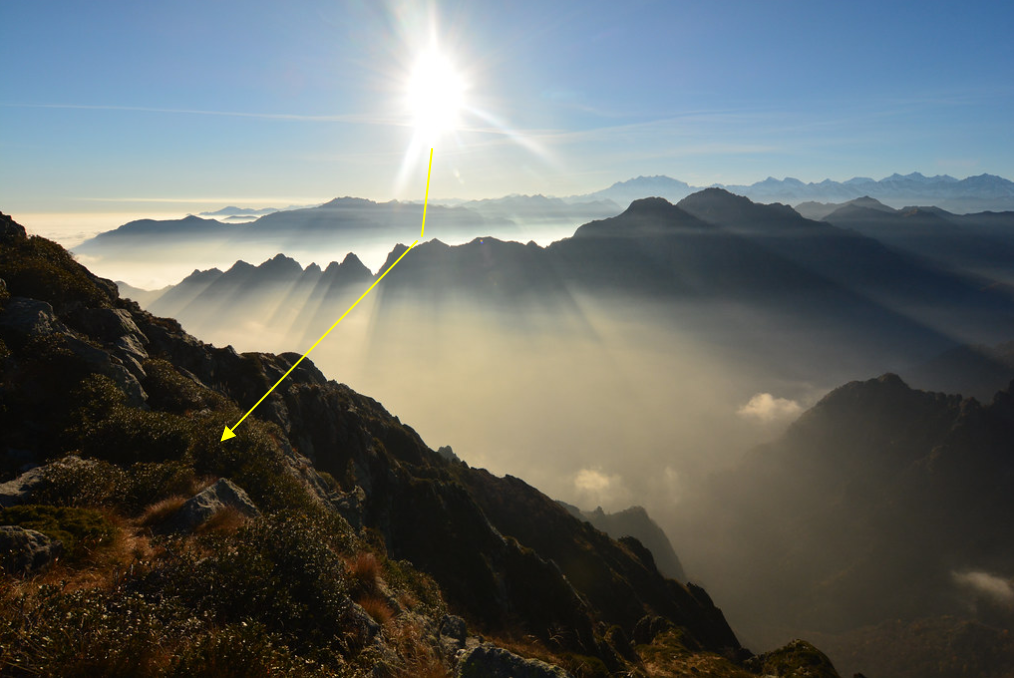
Pic. 29, 30 – Examples of the haze reflection, when the Sun is low above the horizon. The yellow arrow marks the plane of incidence with the biggest reflectance. Picture 24 marks the border of haze light reflection by overexposure, which makes the haze deck as bright as the Sun is. In both cases, the haze brightness tends to be lower as it moves further from the normal (where the arrow bends), as described earlier (Michele d’Amico, milktrayguy/Flickr.com).
It doesn’t mean, that haze reflects the light only. The light is still scattered, and we can see it standing above the phenomenon. Only a small part of scattered light comes to the observer’s eye, however, the effect can be easily noticed, when we turn sight away from the solar direction and watch how the haze deck becomes darker and darker. The principle here remains the same as described previously. When the angle between our sight and the Sun is higher than 90 degrees, then we are facing backward scattering. We are considering the haze, however, in the case of mist or dust, the mechanism will be pretty much similar, as the chemical and optical properties have been omitted at this moment.
The haze layer is mostly smooth, however as it happens during the inversion, very often it appears in hand with the clouds. The clouds aren’t smooth enough, and very often remain on the rough seawater surface. In this event, the angle of light reflection will be wider. Moreover, the cloud represents the area, where the dew point is reached, which enhances the light reflection feature a lot. On the other hand, roughness causes breaks between the illuminated path and shaded areas. Each cloud protrusion will cast a shadow, and consequently block the sunlight for another cloud. If we have both haze deck and clouds visible at the top of the inversion layer, then we can see the significant difference in light reflection and scatter (Pic. 31).
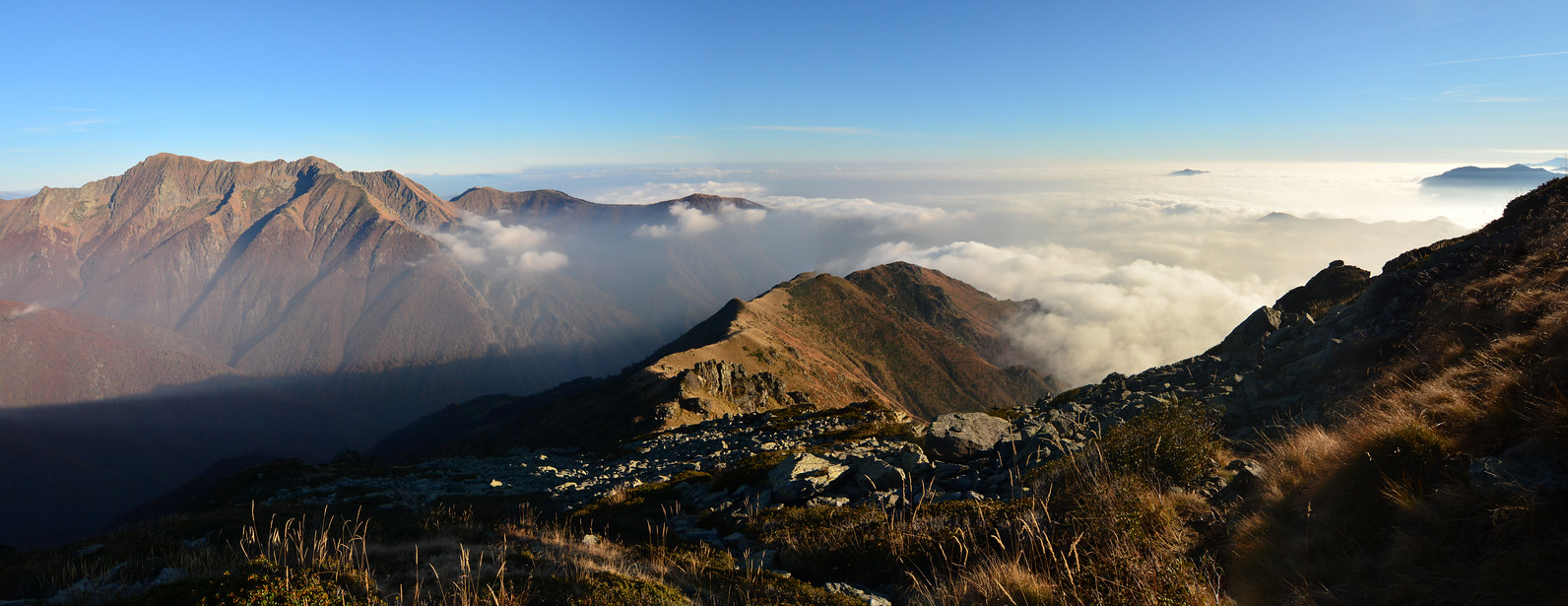
Pic. 31 The inversion layer is comprised of clouds and haze underneath. You can see the big difference between the brightness levels between these two. Because clouds appear with isolated patches, tend to partially shade themselves and the difference with light reflection fades as move our sight towards the normal (Michele D’Amico – Valgrande in Italy, Flickr.com).
Often clouds build more rough surfaces, creating shadows between each other (Pic. 32).

Pic. 32, 33 The typical example of the inversion layer filled up or covered by the cloud deck. Because these clouds can protrude high above the main layer, shadows are produced, which hinders sunlight reflection. See how this light reflection changes in terms of the angular distance from the Sun (27 – Jean Pierre Rouvuier/Flickr.com) 28 – Kevin O’Brian – Snowdonia inversion/Flickr.com).
The same as by the water, an observer can take into account the different planes of incidence (Pic. 10), but without any reasonable appliance, as the cloud deck reflects and scatters mostly the sunlight (or moonlight at night).
Because the reflected light is too faint, the contrast triangle optical phenomenon is rather not observed in these conditions (Pic. 34).
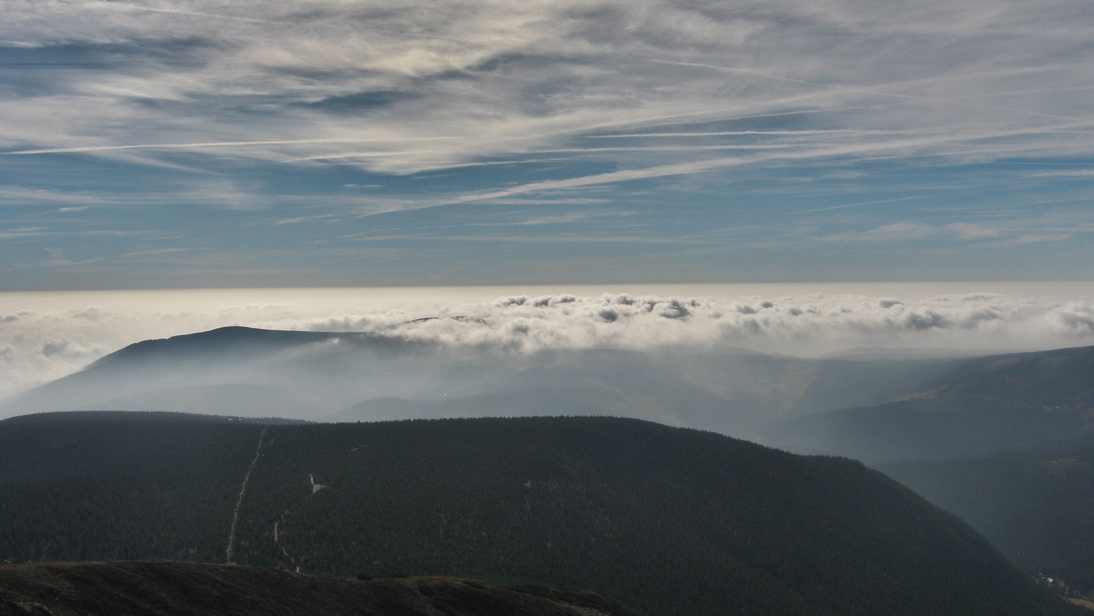
Pic. 34 The inversion above Czechia is seen from the top of the Śnieżka summit in Karkonosze. The haze at the horizon can appear slightly darker, although there is no contrast triangle phenomenon in these conditions.
On the other hand, an observer can see a slight darkening of haze just above the horizon, which looks more extended, as wider light reflects alongside the plane of incidence.
The last condition, which must be considered refers to the twilight time. Both in the water case above and also here, we are taking into account mostly the civil twilight with the highest brightness of the atmosphere near the solar direction. In this event, we should face an analog light reflection. Haze likewise the smooth water tends to reflect the light, but it can be seen mostly near the normal, as the amount of reflecting light is relatively small. Clouds can better handle it, and sometimes an observer can see reddish or yellowish cloud edges, just before sunrise or after sunset (Pic. 35, 36).
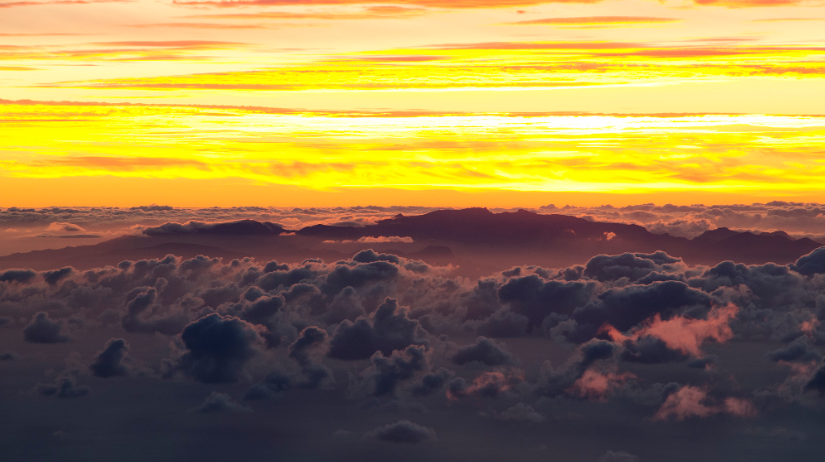
Pic. 35 View on the Pico de las Nievas from the Tenerife before sunrise. The inversion layer lies just underneath. You can spot how the haze deck reflects the reddish light. Clouds do the same much better, however, their shapes cast shadows at once, turning them into a grey appearance (Juanjo Diaz de Argandoña/Beyondhorizons.org).

Pic. 36 Inversion layer, as it looks before sunrise. The light scattered in the atmosphere is reflected on the cloud deck, giving them a reddish hint (Chris Miles – Helvellyn, Lake District National Park in the United Kingdom/Flickr.com).
Well, translating everything into the appliance for distant landscape photography, we must figure out, when the conditions for capturing distant objects or mountains will be the best. Let’s consider it analogically to the situation with water then.
When an observer is standing on some mountain, he can see 3 major levels of brightness, from the inversion layer (haze or clouds), from the object, and also from the illuminated atmosphere beyond. The important thing is, that the observer’s position must be elevated enough to have the haze layer underneath (Pic. 38). This is also a geometrical problem with seeing some extremely distant features, although this is an issue for further writing.
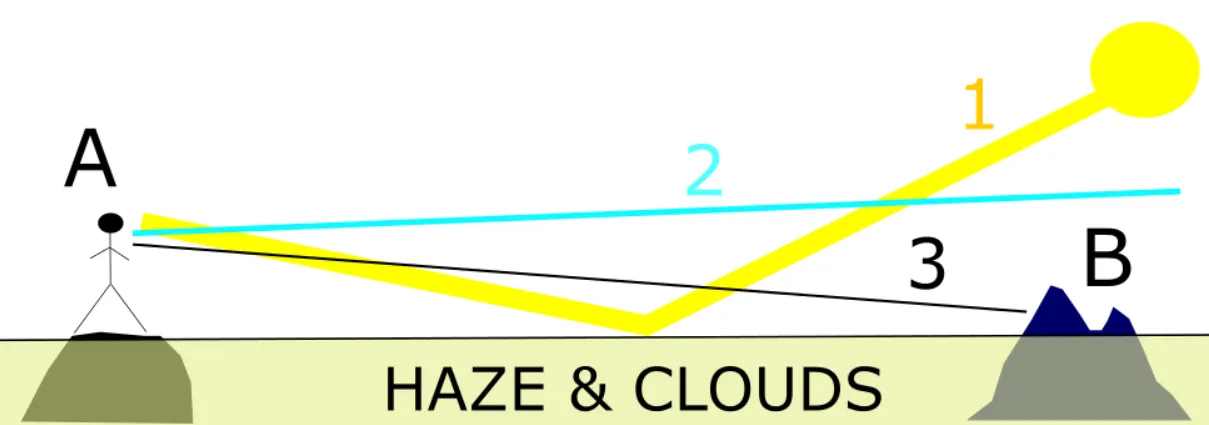
Pic. 38 The visibility pattern for the observer elevated above the inversion layer, where: A – observer’s place; B – distant mountain observed; 1 – solar beam reflected on the haze or clouds; 2 – scattered light coming to the observer; 3 – the object appearance, which makes perfect contrast both with the horizon beyond and the layered haze reflecting the sunlight.
There is another thing, that comes to mind when speaking about mountains. This is the snow coverage. In the case of the sea, there is no such important role here, as the snow surface is not as perfect for specular reflection as it could be unless it’s a glacier, the water usually scatters light much more efficiently drawing out the object illumination and putting it into the darker appearance. In the case of mountains and haze, where we are dealing with the fainter amount of reflected light it plays an important role in the contrast and ability to see this object from a huge distance. The principle is, that snow cover is an advantage in seeing the distant features, because of the high albedo ratio. This is absolutely true, but not necessarily towards the solar azimuth when we have a bright cloud deck or haze underneath.
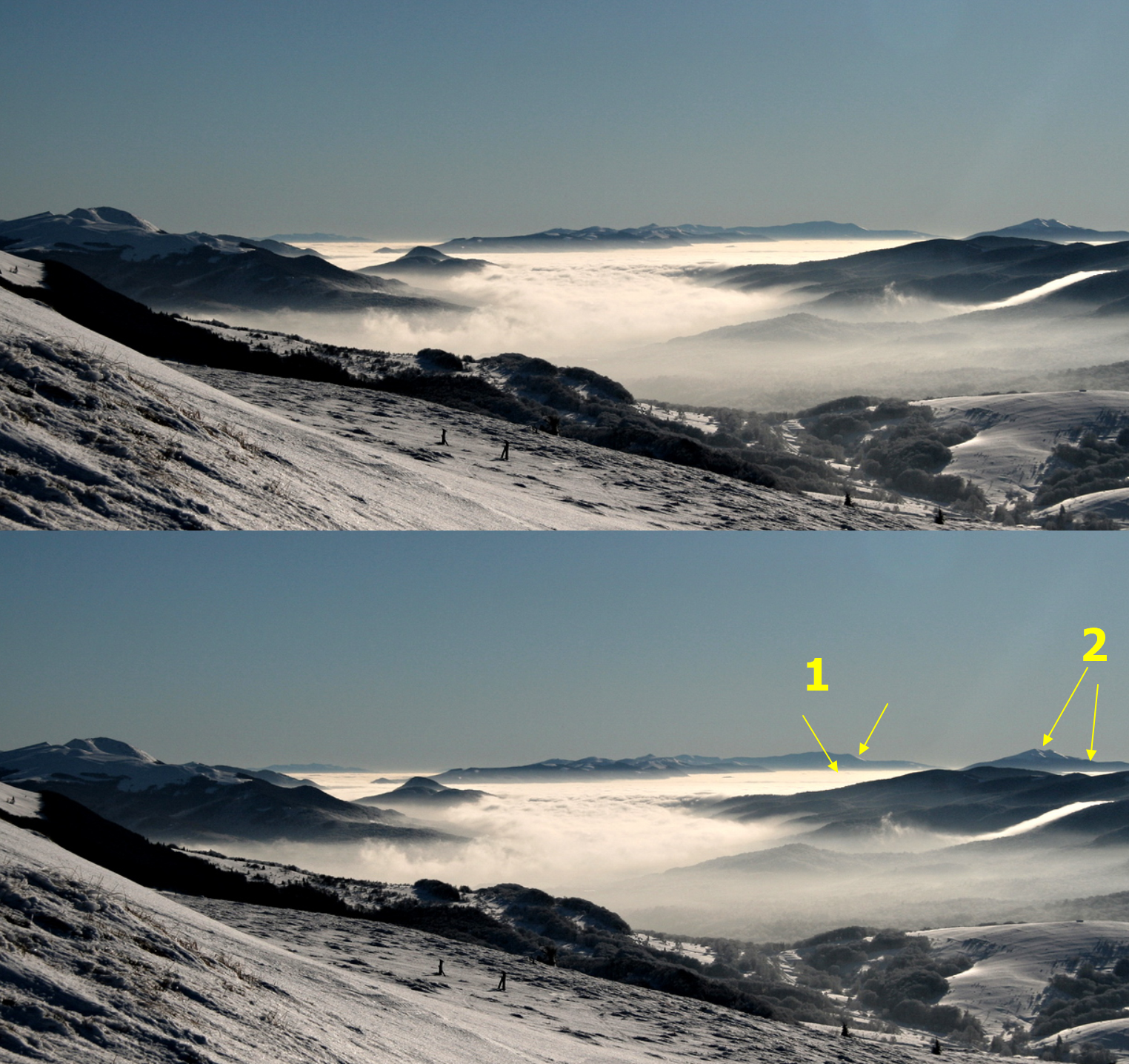
Pic. 39 The Eastern Carpathian saw from Bieszczady in Poland during the inversion conditions, where 1 – the difference in contrast between snow-capped illuminated slope and illuminated cloud deck; 2 – the contrast difference between snow-capped and forested slope (Bogdan/Dalekieobserwacje.eu).
The snowy mountains are the best visible, but not just under the Sun when the haze or clouds reflect the sunlight. As a result, the contrast between the illuminated haze or clouds and the horizon beyond tends to flatten, making objects less visible. However, in practice, this direction often means, that these mountains shade themselves, especially during the winter when the solar path is not really high. In this event, the snow albedo will play a minor role, since it reflects the scattered light only. Looking at the image above (Pic. 39), where the situation from Bieszczady Mts is presented, we can see how it works in actuality. For closer distances, the contrast determined by the treeline is quite big but almost disappears, as we watch the further mountains. More important is the slope exposition, which can be illuminated by the sun. If it happens near the plane of incidence, the contrast is strongly deteriorated, which you can see above.
In any other situation, when the observer looks at the distant objects above the inversion layer, the snowy mountains will always appear the best, because the albedo of snow is slightly higher than clouds or haze. On top of that, the illumination of the horizon won’t be as strong as towards the solar azimuth.

Pic. 40 Inversion layer in the Lake District (United Kingdom), where the picture was taken at the right angle distance from the Sun. As a result, you can see the brighter part of the clouds on the right and darker ones on the left. They are divided by the border between forward and backward scattering. As a consequence, forward scattering emphasizes the contrast with mountains seen beyond (Robin Lockwood – Helvellyn, United Kingdom/Flickr.com).

Pic. 41 The contrast between the remote Nagy-Gerecse hill has been enhanced by the haze layer reflecting the solar beams, which is brighter than the horizontal sky in the background (Maciej Majewski/Refraktor.pl).

Pic. 42 One of the alpine peaks seen from the Vel’ka Fatra in Slovakia in favorable conditions, when the sunlight is reflected by the haze deck underneath, enhancing strongly the contrast with the mountain observed (Maciej Majewski/Refraktor.pl).
Unlike the ocean conditions, where the observer is located in the majority of cases inside the atmospheric boundary layer, the person standing above the inversion layer is located in the “free atmosphere“, not violated by various particles. It makes the objects visible as long as they appear black against the sky beyond.
The same as water, the inversion layer can be affected by shadows produced by a higher level of clouds. When the observer is not high enough above the layer haze, he can spot some faint and fuzzy patches, that can temporarily influence the contrast between the distant objects or even mistake them for some mountain ridge touching the inversion top. If the sight is high enough, then the observer will spot some big fuzzy spots on the inversion layer (Pic. 43).

Pic. 43 The partially shaded layered haze (marked by red arrows)(Joel Sax – Santa Ana River Canyon/Flickr.com).
Now let’s have a look at what happens during the twilight. Because of the smallish amount of light reflected by haze, it won’t be a difference in contrast between the distant object, which will be deemed as an integral part of the land. Clouds can be able to produce some contrast with some bulging mountains, although because of their tumultuous character, they can hide these mountains at once when the observer is not high enough. The higher elevation of an observer can make a decent contrast between the clouds or haze, reflecting and scattering the light from the atmosphere and the bulging mountain, which tends to be black.

Pic. 44 Hungarian peaks are seen from the Low Tatras in Slovakia before sunrise. (Radosław Wierzbiński).
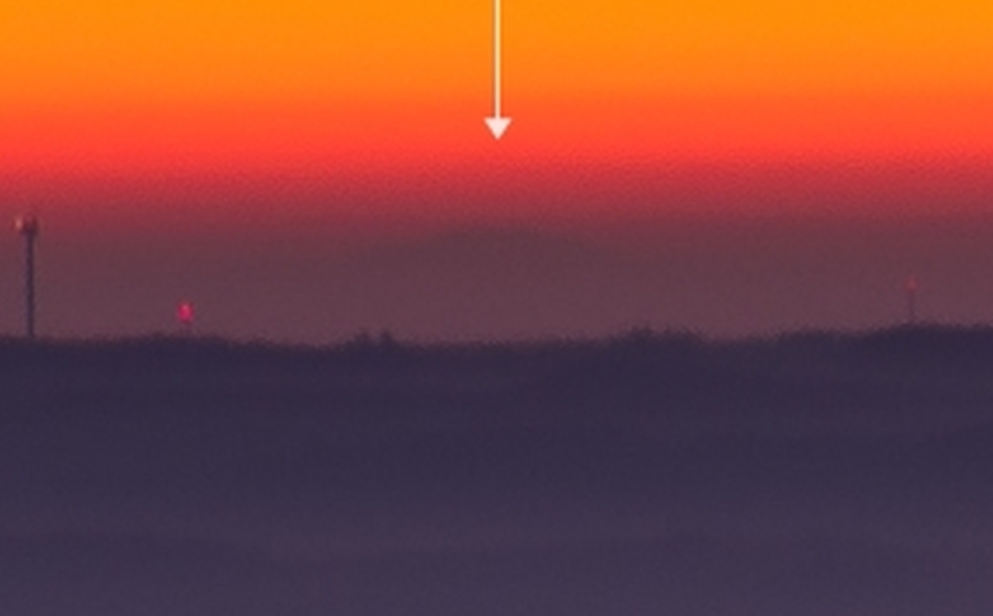
Pic. 45 The silhouette of Schneeberg seen from Praded mountain (277km). The mountain has some faint contrast with the haze deck underneath, which reflects the light scattered in the atmosphere after sunset. Here the situation is different than above because the distant object makes also contrasts with the horizon sky beyond, not with the inversion layer only (Robert Jamróz/Dalekieobserwacje.eu).
4. THE SITUATION IN THE LAKE DISTRICT NATIONAL PARK
In the late afternoon of June 22, 2019, I reached the top of Helvellyn Mountain (950m.a.s.l.), which is the highest in the Helvellyn Massif, the 2nd highest in the Lake District National Park, just after the Scafell Pike. The mountain itself is placed in the 4th position. Nevertheless, the theoretical visibility cloak is as wide as from the top of the Scafell Pike. The weather at that moment was good, with almost no wind and quite big relative humidity. The area, where the tunnel of clear air approached, was spreading more or less between the Cumbrian Mountains, Cambrian Mountains, Northern Ireland, and the southwest area of Scotland, with towering Galloway Forest Park. The vistas towards the east direction were strongly deteriorated by haze. A good example you can find below (Pic. 46), is a reference to the situation, which I am going to show you later.

Pic. 46 The direction towards which the Snowdonia National Park mountains should be visible on a clear day. On June 22 late afternoon, they weren’t visible to the naked eye. After the strong image processing, the mountains are near the contrast threshold. Distance about 150-160km.
Now let’s have a look at the weather circumstances for that area. I have picked up 6 stations, showing the data roughly for June 22, 2019, 18:00 UTC, the moment, when my observation was done (Pic. 47).
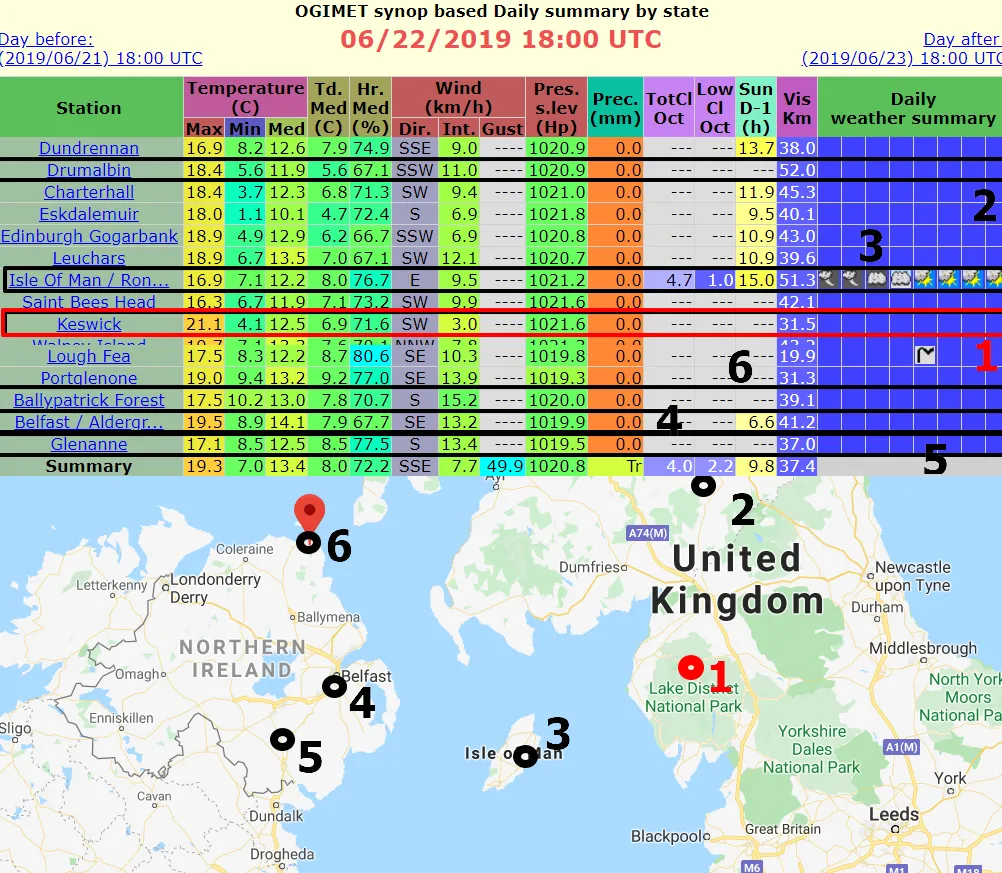
Pic. 47 The Ogimet weather data for the region, as shown on the map with all stations market (Ogimet.com/Maps.google.com).
The humidity level was between 60-70%, however, we must take the altitude alteration into account, where the air was dryer a bit, especially towards the west.
Now see the general view towards the western part of the Lake District National Park and the Irish Sea beyond (Pic. 48). The areas with telephotos have been marked by red boxes, which I will follow from the left to the right. It is very important, as we are looking closer and closer to the plane of incidence with the Sun created by seawater and the haze layer above.

Pic. 48 View towards the western part of the Cumbrian Mountains with the Irish Sea beyond. Red boxes indicate further close-up views of the situation. The lower part of the image has been processed.
As a first, I captured the Slieve Croob hill (534m.a.s.l.) near Newcastle town in Northern Ireland. It was a challenge because I knew its position at the horizon, however, the hill contrast appearance was nearly the just-noticeable-difference (JND)with the thick haze layer around (Pic. 49), so quite advanced processing was required. Anyhow, the silhouette of this hill, and also the adjacent Slievenisky (446m.a.s.l.) is detectable.

Pic. 49 The Silhouette of Northern Ireland hills near Newcastle visible (after strong processing) from the Helvellyn mountain, where: 1 – shaded sea surface; 2 – Slieve Croob hill, Slievenisky hill (according to Udeuschle.de/panorama). Both are seen from the 192km distance.
Just “underneath” these hills, an elongated shadow on the seawater can be also noticed. It was also barely seen by the naked eye when I stood just under the Helvellyn peak. Again, it can be mistaken for some distant landscape features. In this event, it’s not, as the silhouettes beyond have rounded shapes.
As my sight was approaching the solar azimuth, the Sea became brighter, although the thick haze layer too.
The Divis Hill towers just above Belfast – the capital of Northern Ireland. It can be also seen in Helvellyn. Thanks to the considerable light reflection by the sea towards that direction, I could spot it barely after the image processing (Pic. 50).
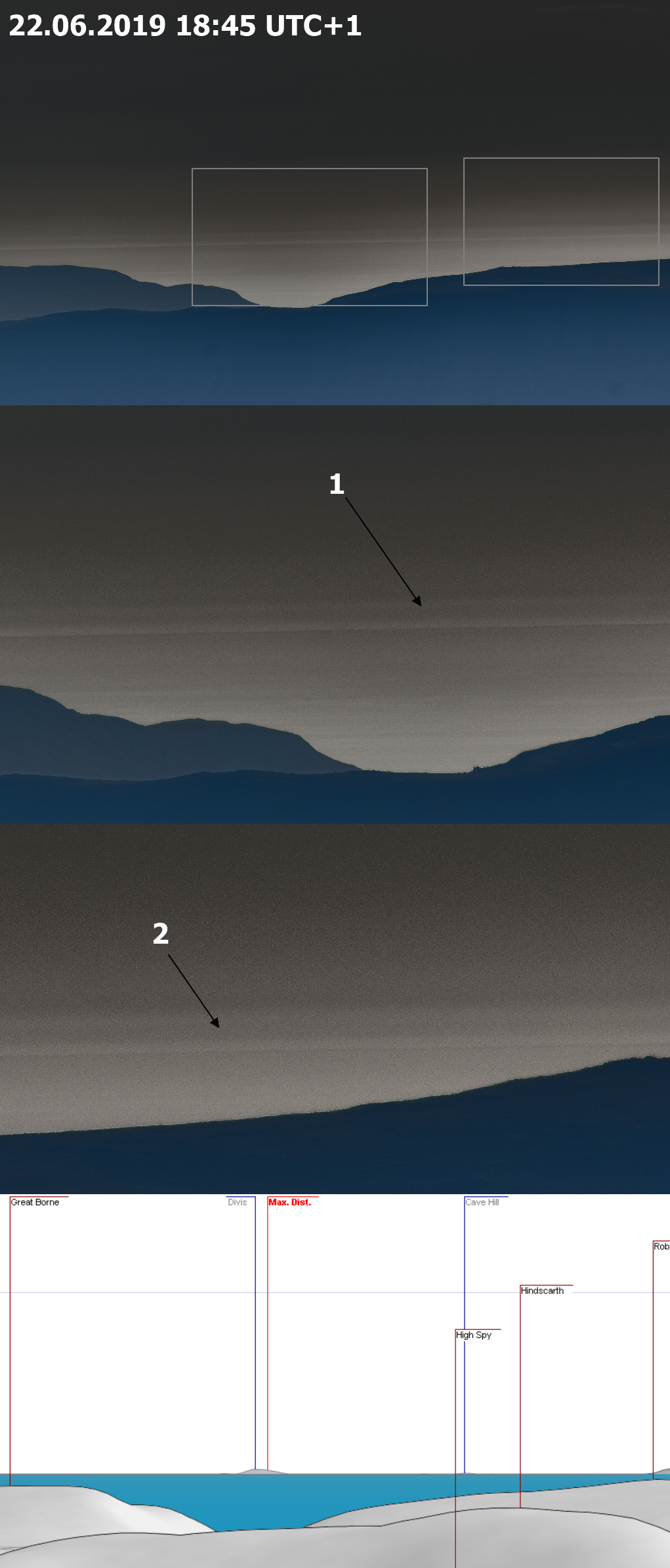
Pic. 50 View towards Divis (1) and Cave Hill (2) barely visible above the illuminated water body, after image processing. Distance to Divis – 194km, to Cave Hill 193km (Udeuschle.de/panorama).
The hills above would make a better contrast with the illuminated sea, although they were located inside the haze layer, where the strong forward scattering almost completely washed them out. This is simply the just-noticeable-difference (JND) example, which is used in measurements of the visual range deteriorations. It’s also a good example of Just-noticeable change (JNC).
The Just-noticeable change (JNC) (Ross et al. 1990) can be understood in two ways depending on the conditions, where:
– the observer is watching the distant horizon above the haze layer (layered-haze case), where the layer haze makes the contrast with the scene itself. JNC says whether the observer can see this haze or not.
– the observer is watching the distant horizon within the haze layer, where the contrast edge is at its threshold value. In this event, the question is how much more haze we need to make the contrast edge drop below the perception threshold, or conversely how much haze must decrease to allow some contrast edge to be visible. The JNC issue is also for wider discussion in the future. For my situation, it can be applied between these hills, located at pretty much the same distance from Helvellyn peak. Seeing situations such as this I can gauge where the relative humidity level was bigger and was it was a bit lower, allowing me to see the object by the contrast sensitivity threshold of my eye.
The last shot almost directly at the solar azimuth was the best. I could spot Agnew’s Hill with the naked eye. This is a big hill rising near Larne, north of Dublin (Pic. 51).

Pic. 51 Agnew’s Hill near Larne in Northern Ireland, seen from the top of Helvellyn Mountain, from 191km (Udeuschle.de/panorama).
I didn’t need any image processing to be honest to spot this hill in the background (Pic. 52). The principle of light reflection described by Fresnel law came definitely through the effort, making an exceptional contrast with the Rhins of Galloway Penninsula in southwestern Scotland. The headland is about 120km distant from Helvellyn peak.
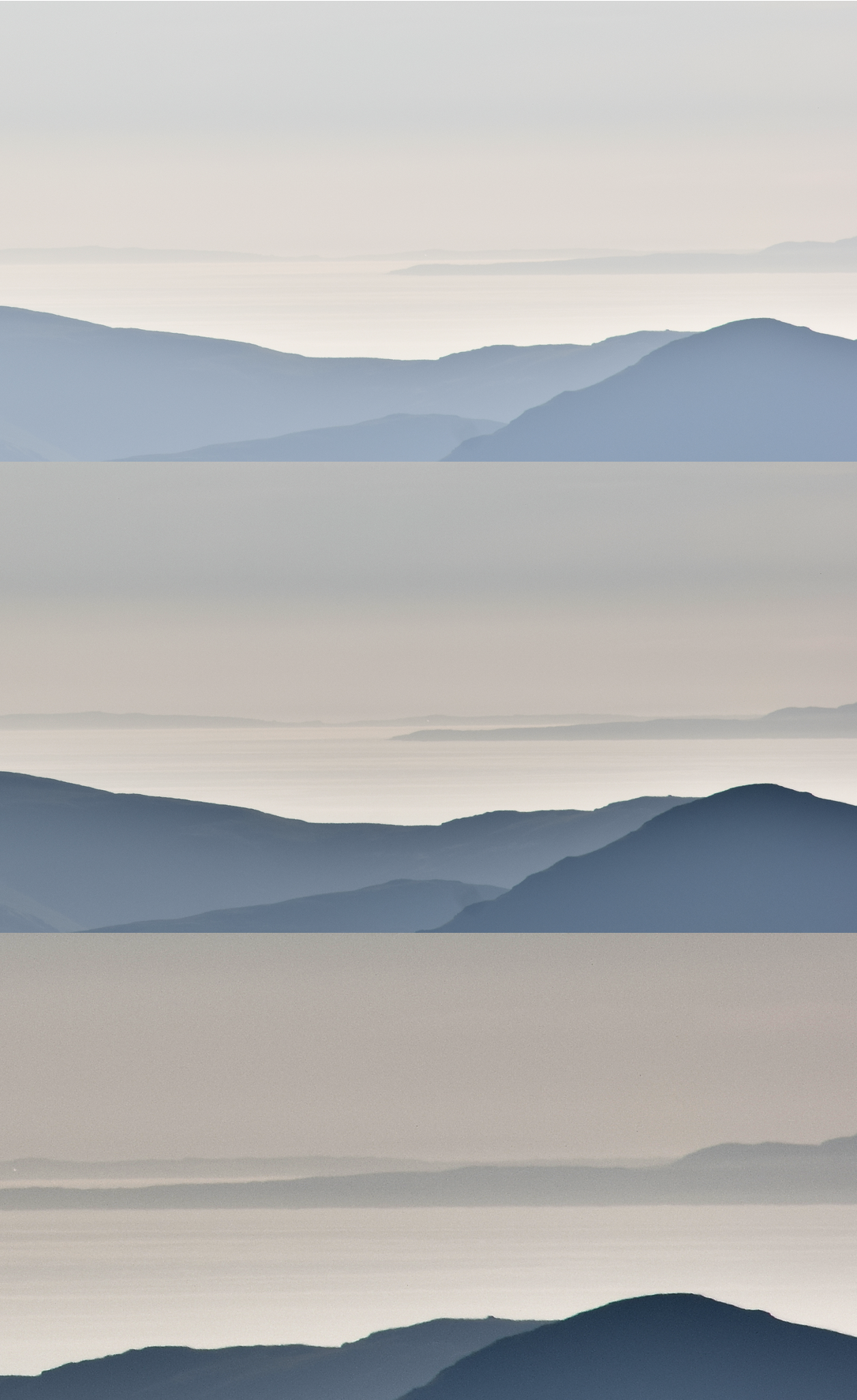
Pic. 52 The Rhyns of Galloway peninsula and Agnew’s Hill beyond seen from Helvellyn mountain. The top image hasn’t been processed and the mountain is still barely visible to the eye.
Now I would like to show you the view towards the Scottish mainland, taken at the same time (Pic. 53-55). The top image is crude, bottom one is processed.
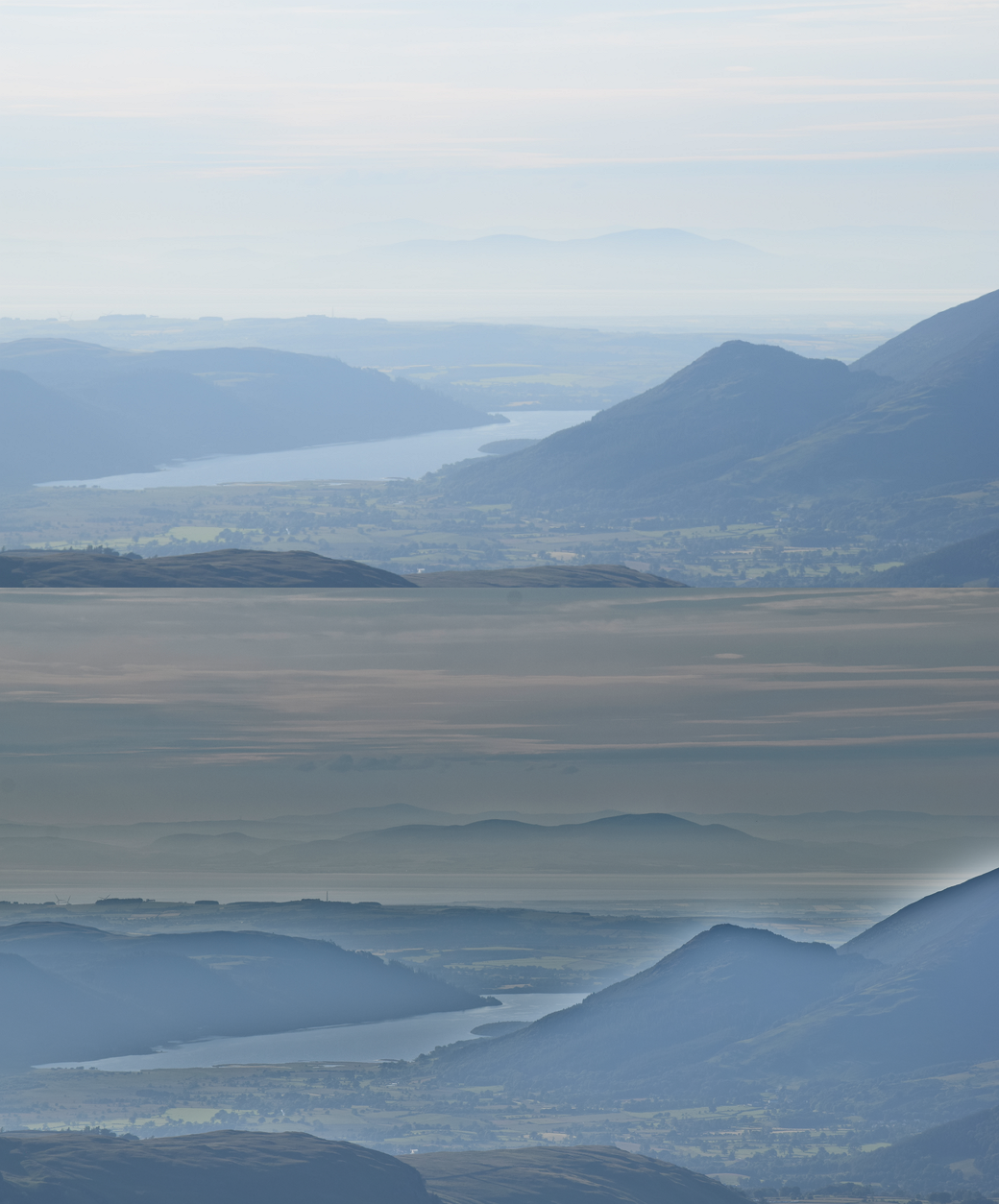
Pic. 54 The Keswick basin with Bassenthwaite Lake with the Merrick – the highest peak of Galloway Forest Park beyond (115km).
At the finish, I would like to show you a simple map of the places, I saw that day, or at least today, processing the images 🙂 (Pic. 56).
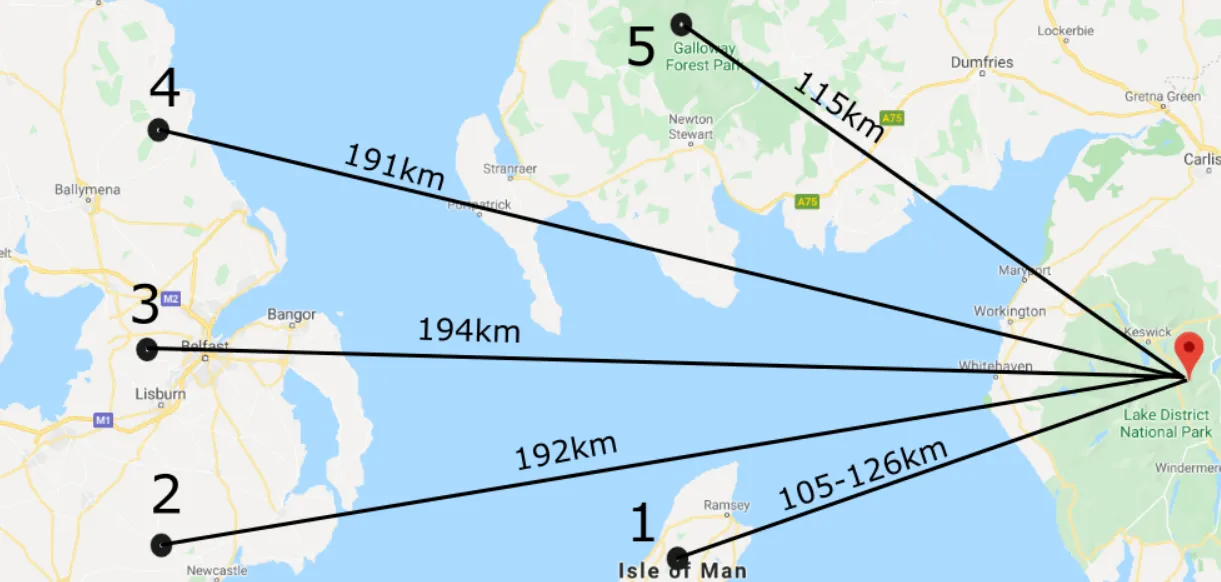
Pic. 56 Distant features observed from Helvellyn on the June 22, 2019 evening (18UTC), where: 1 – Isle of Man; 2 – Slieve Croob near Newcastle; 3 – Divis & Cave Hill above Dublin; 4 – Agnew’s Hill near Larne; 5 – Merrick, the highest in the Galloway Forest Park.
4. VISIBILITY OF ROMANIAN EASTERN CARPATHIANS MOUNTAINS FROM SLOVAK HIGH TATRA MOUNTAINS – CASE STUDY
Here I would like to describe a potential situation to see the Apuseni Mountains range, located in western Romania from the Slovak High Tatra Mts. According to the SRTM models, these mountains are theoretically visible from the highest Carpathian range. The problem lies in the extremal distance, which is longer than 300km, which means, that even in the “free atmosphere” the forward light scattering can deteriorate the vista enough and make it invisible to an observer. Counterintuitively to the literature, which was published several years ago, where digital photography wasn’t popular enough, especially within the distant landscape features, there are quite a few reported views of the distance 300+. Probably the authors meant the visibility by the naked eye in daylight conditions. The oldest world record hits 330km in the USA & Canada territory, which was mentioned by viewfinderpanoramas.org in 2009. Nowadays in Beyondhorizons.org and Dalekieobserwacje.eu we can find a bit more. Some of them are done in daylight conditions apart from sunrise/sunset or twilight period, on the other hand, these ones done throughout the day have been processed. Nevertheless, observations of 300+ in daylight are possible, and the best example is the longest distance photographed within 1 country, where the Pyrenees Mountains have been covered from Sierra de Tramuntana in Mallorca.
A similar distance can be also covered in the other direction, from Tatra Mts to Apuseni Mts in Romania. In my opinion, the most favorable conditions to make it can occur near the winter solstice, when:
– The Sun is yet below the horizon and is about to rise. The sunrise azimuth is different, but the illuminated atmosphere in civil dawn is extended, so should cover the Apuseni azimuth too.
– The Sun is exactly at the Apuseni Mts azimuth (Pic. 57) and inversion takes place.
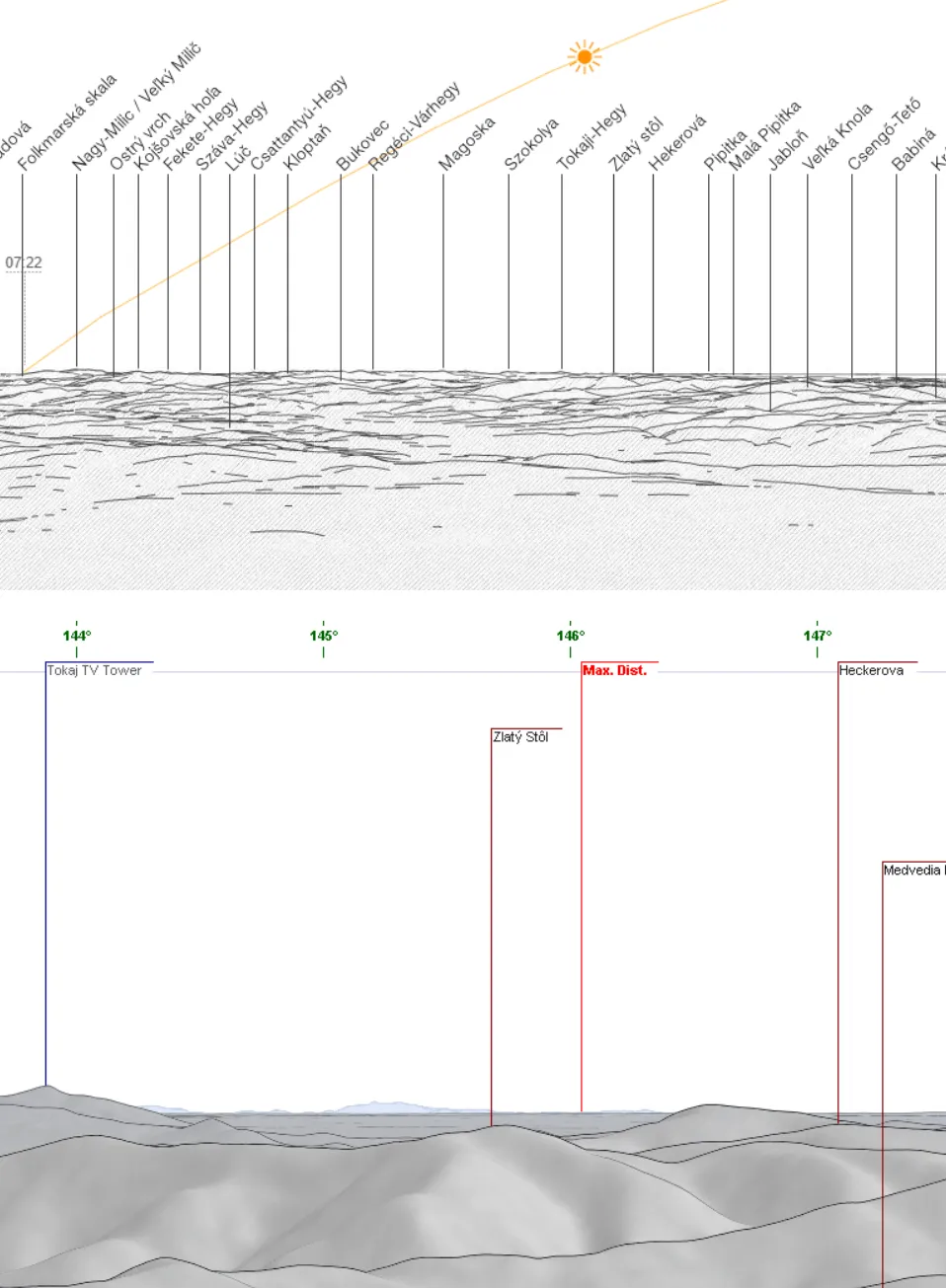
Pic. 57 The simulated view of the Apuseni Mountains is possible to see from the Łomnica Peak in the High Tatras with the solar position corresponding to the winter solstice day (Peakfinder.org/Udeuschle.de/panoramas).
Imagine, that the view, that you see now is mostly covered by the thick haze deck, typical for inversion. The plain behind the Zlaty Stol peak is smooth and tends to reflect the sunlight. When the Sun is exactly above the Apuseni Mountains, then light reflection occurs along with the angle of incidence. If these far mountains are not covered by snow, which happens only rarely at that time, they can be better visible then. However, as I mentioned above, shaded snow won’t be a big problem, as it reflects only the light diffused in the atmosphere, which is much less bright than the solar one. In general, the situation would look as per the pattern below (Pic. 58).

Pic. 58 The graphic pattern showing the possibility of viewing the Apuseni Mountains from the High Tatras in Slovakia, where: A – observer located at the top of Łomnica peak; B – Apuseny Mountains at the 338km distance; 1 – sunlight reflected from the haze analogically to the Fresnel law principle; 2 – Scattered light from the distant near-horizon sky, beyond the Apuseni Mountains; 3 – the line of sight between the Apuseni Mountains and the observer, which passes just above the inversion layer.
Basically, we need to know, that the high level of the inversion won’t be really helpful in this case, as the mountain silhouette is shrunk this time. I will explain it more in the future. Now, just elaborate on the pattern above. The combination of shaded Apuseni Mountains and haze deck reflecting the biggest amount of light should emphasize the contrast, cutting off the mountain silhouette. The horizon beyond these mountains will be the brightest, as it is located straight under the Sun. The only thing, which can hinder the observer before seeing the mountain is the most intensive light scattering on the “free atmosphere” molecules.
These two instances don’t mean that this vista is not possible during the other conditions, which the best example comes from the Kralova Hol’a peak, when recently this group of mountains was seen (Pic. 59). When the Sun is located west of the southern azimuth, then snowed Apuseni mountains start to reflect the light, and so forth.
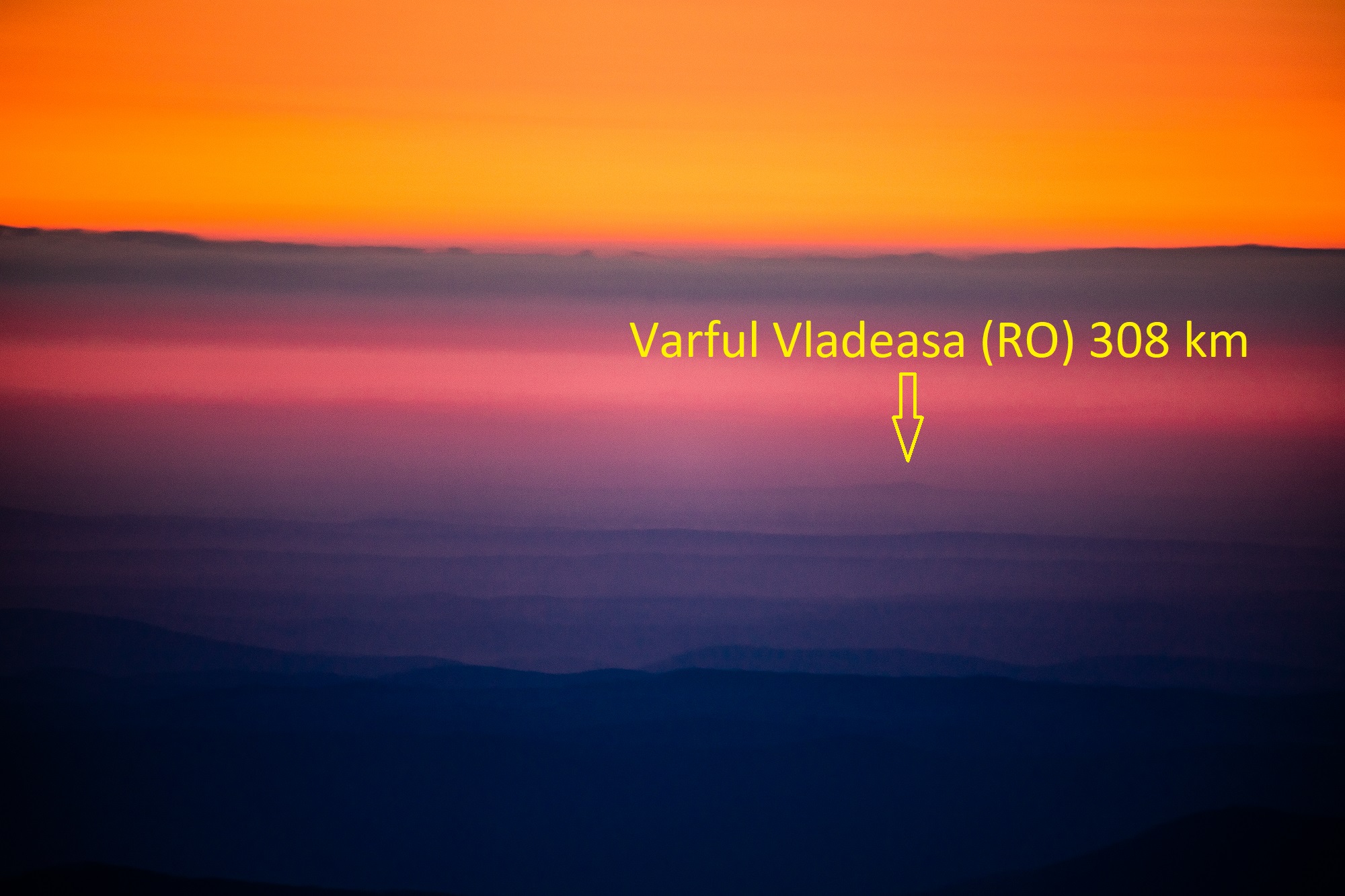
Pic. 59 A recent view of the Apuseni Mountains from the Low Tatra Mts in Slovakia [Kralova Hol’a] (Michał Skiba/Dalekieobserwacje.eu).
This wide report shows light reflection behavior with the appliance to see the long-distance features. Based on my own observations I found, that the illuminated sea can be a reason for the extended visual range. Firstly, the contrast triangle can make somewhat an illusion of haze reduction, where the horizon appears a bit darker, which lifts up the contrast of distant features with a strongly illuminated water body making them slightly better visible. Secondly, the illuminated sea reflects the light better than any landmass, except for the glaciated area, which features a higher albedo. threading this way, the contrast between any landmass and lit-up water body tends to be higher, allowing an observer to spot the distant features, that wouldn’t be normally seen under these weather conditions. It’s not a big change as during the sunrise/sunset transition or total solar eclipse phenomena, because there is rather no shadow role in it, and both sea and land and the horizon sky beyond are illuminated. Saying “rather” I mean, that the shadowed areas seen on the water surface don’t impact this process unless the shadow doesn’t appear too often, where this phenomenon is effectively gone.
According to my observations done in Lake District National Park, the difference is haze-dependant, likewise in the example of the total solar eclipse. A general lack of the light transition process driven by lack of shadow (except for small shaded areas on the sea at the line between observer and distant object) makes much less harsh differences in the visual range changes. Bringing my example from the Lake District I would say, that the visibility threshold has been pushed about 50km ahead. It corresponds to the third-fourth value of the beta attenuation coefficient changes, known from the situation with the solar eclipse. The biggest visual range extension applies only to the plane of incidence, where the light reflection builds the strongest contrast.
Apart from the water, a similar phenomenon happens with layered haze. It can happen in a similar way, because the light reflection is not as big as on water, although the haze deck has a bigger albedo. Nonetheless, it requires further observation and studies, especially in situations, where the distant objects are located near the human contrast sensitivity threshold, which often happens during the observation of extremely distant landscape features.
Mariusz Krukar
References:
- Lynch D.K., Livingston W., Color and Light in Nature, Cambridge Univ. Press 1995
- Minnaert M.G.J., 1993, Light and Color in the Outdoors, Springer-Verlag, New York
- Rafferty P.J., 2011, Oceans and Oceanography, Britannica Educational Publishing, New York
- Ross H.E., et al., 1988, Human detection of layered haze using natural scene slides with a signal detection paradigm, (in:) Proceedings of the 81st annual meeting of the Air Pollution Control Association, Pittsburgh
Links:
- Maxwell’s equations and electromagnetic waves
- Impedance
- Maxwell’s equation and light
- Reflection of waves
- Reflection of light
- Seawater optical properties
- Bragg scattering
- Fresnel equations – calculator
- Fresnel equation for reflection and transmission
- Sun’s glitter
- https://www.scienceabc.com/nature/why-does-the-sun-reflect-off-seas-and-oceans.html
- Haze – lab experiments
Forums:
- https://physics.stackexchange.com/questions/210607/why-does-water-reflect-light
- https://www.quora.com/Does-water-reflect-light
- https://www.quora.com/What-does-impedance-mean
- https://physics.stackexchange.com/questions/402675/can-refractive-index-be-used-interchangeably-with-wave-impedance
- https://www.quora.com/Why-do-rough-and-smooth-surfaces-reflect-light-differently
- https://physics.stackexchange.com/questions/110820/why-does-sunset-over-a-body-of-water-cause-a-path-of-light-stretching-towards-th
- https://www.metabunk.org/threads/reflection-of-the-sunlight-on-water.8324/
- https://www.quora.com/What-is-the-difference-between-angle-of-incidence-and-angle-of-reflection
- https://www.quora.com/What-is-the-difference-between-mist-and-haze
- https://www.quora.com/What-is-the-mechanism-for-light-scattering
- https://www.quora.com/What-is-the-difference-between-mist-fog-smog-haze-and-vog
- https://www.quora.com/What-is-the-difference-between-single-scattering-and-multipe-scatttering
- https://wtamu.edu/~cbaird/sq/2014/02/12/can-air-make-shadows/
- https://www.researchgate.net/post/The_scattered_beam_is_stronger_in_forward_or_backward_directions_rather_than_in_directions_at_right_angle_to_incident_beam_Why
Wiki:
- Albedo
- Angle_of_incidence_(optics)
- Brewster’s angle
- Bragg’s law
- Geometrical_optics
- Fresnel_equations
- Lambertian_reflectance
- Maxwell’s equations
- Normal_(geometry)
- Penetration_depth
- Reflectance
- Reflection_(physics)
- Refractive_index
- Sun_glitter
- Visual_appearance
- Wave_impedance
- Waviness
Read also:
- Visual range changes during solar eclipses
- Horizontal visibility as the main factor of long-distance observations, part2 – contrast, human perception, and weather forecast
- Horizontal visibility as the main factor of long-distance observations, part1 – weather, astronomical and optical elements
- Why the haze is an important weather factor – impact on visibility and light scattering
